Halo Waypoint/Universe/Vehicles
UNSC Frigate[modifier | modifier le wikicode]

| « | Frigates are relatively small and fast UNSC combat vessels, designed primarily for their speed and effective armament. —
|
» |


UNSC Frigate
Classes: Stalwart, Charon, Paris, Strident
Purpose: Combat and escort
Primary Armament: Mark IV, Heavy Coil - 94B1E6/MAC
Secondary Armament: M42 Archer Missile Delivery System
Tertiary Armament: M870 Rampart 50mm Point Defense Network
Quaternary Armament: M4093 Hyperion Nuclear Delivery System
Summary
Easily one of the most critical vessels within the UNSC Navy during the course of the war, humanity’s frigates are light combat ships designed for speed, maneuverability, and firepower. The most recent addition to the frigate type is the Strident-class, lean and lethal machines, which pack incredible firepower. They include a Mark IV ship-mounted MAC and three Hyperion nuclear warheads—weapons even capable of defeating a variety of Covenant capital ships if their shields are down.
In fact, Strident-class frigates are considered so invaluable that even the enormous and powerful UNSC Infinity carries a number of them, underslung within its sub-vessel deployment bay. After an initial assault, these are deployed en masse, delivering a final, crushing blow and mopping up any stragglers in the process. Without question, frigates remain at the center of the UNSC’s naval dominance in the years following the Covenant War.
Classes
Charon (1,607ft/490m)
While not as greatly armed or armored as other similar vessels, Charon-class light frigates have the capacity to carry a large complement of troops and vehicles into battle.
Paris (1,755ft/535m)
During the invasion of Reach in August 2552, the Epsilon Eridani Fleet deployed vast numbers of Paris-class frigates in defense of the local colonies. Though out-numbered, these heavy frigates proved their worth in battle thanks to additional armor plating that increased their defense against the Covenant arsenal and their surplus of armament compared to standard frigates.
Stalwart (1,568ft/478m)
Designed with planetary defense in mind, Stalwart-class light frigates enjoy great success due to their superb balance between troop transportation and fleet support.
Strident (1,887ft/575m)
Prominent in the years following the Covenant War, the Strident-class heavy frigate is an incredibly fast and agile UNSC capital ship capable of precise naval combat. As many as ten Strident-class frigates can be docked inside the UNSC Infinity's sub-vessel deployment bay. One significant change between these ships and previous models is the addition of energy shields rather than a reliance solely on the ship’s outer hull for protection.
Argent Moon[modifier | modifier le wikicode]

| « | Argent Moon was an ONI-controlled research facility where unauthorized and potentially dangerous biological testing was allegedly carried out. —
|
» |


Argent Moon
Research Facility
Affiliation: ONI
Role: Research and Development
Entered Service: May 7, 2553
Destroyed: October 23, 2558
Summary
There have long been reports that ONI routinely experiments with technology retrieved from the Halo installations, using standalone production facilities as remote test platforms to conduct potentially hazardous research. While it had been speculated that Argent Moon was one such site, it wasn’t until recovery efforts found traces of unsanctioned stealth technology and documentation of an experimental biological weapon in its wreckage that those suspicions were confirmed.
Design
The Argent Moon, while loosely resembling some of the deep survey craft designs of the 22nd century, is actually not a ship at all, but rather a large-scale production plant. With navigation and operation controls at the fore and maneuvering propulsion systems aft, the bulk of Moon’s activity occurs in between these, within a massive, city-sized superstructure. It’s here that ONI crews work on highly classified and experimental projects, as well as a variety of weapons testing.
History
Argent Moon’s existence remained a secret for years, until it unexpectedly was destroyed, leaving investigators to sift through the debris for clues. Although the Moon’s shipboard AI was irreparably damaged when the station exploded, salvaged data suggested the station’s laboratories were dedicated to producing a weaponized biological agent which would remain dormant and asymptomatic as it spread through a population before being activated by an otherwise harmless aerosol dispersant.
Partial station records further revealed that laboratory containment was breached and Argent Moon’s research and habitation areas were exposed to a particularly aggressive form of the agent. Contamination was total, and the strain’s high fatality rate resulted in the total elimination of the crew. Quarantine protocol was automatically engaged, but none of Argent Moon’s mandated warning beacons successfully deployed.
The empty station drifted until it was boarded by a group of Kig-Yar scavengers, who in turn sold their find to Jul ‘Mdama’s Covenant. Ignorant of any biological threat, ‘Mdama’s team boarded the Argent Moon. Soon after, the station was destroyed, with little indication of the cause.
Banshee (original)[modifier | modifier le wikicode]

| « | The Banshee is easily the Covenant’s most common support aircraft, offering extremely high maneuverability alongside an impressive armament. —
|
» |

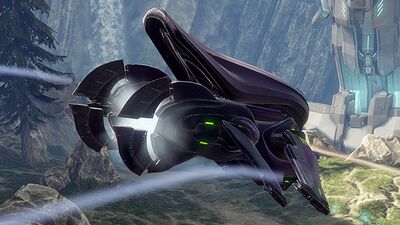
Banshee
Support Aircraft
Manufacturer: Assembly Forges, Lodam Armory
Crew: 1 pilot
Length: 22.8 ft (7 m)
Width: 24.7 ft (7.5 m)
Height: 11.5 ft (3.5 m)
Weight: 2.5 tons (2.3 tonnes)
Primary Armament: DEML-AW (2), Plasma Bolt/Diffused (Class-2)
Secondary Armament: HAAW/M, Heavy Fuel Rod (Class-3)
Summary
The Banshee is easily the most common support aircraft employed by the Covenant, and were deployed in the hundreds of thousands during the course of the Human-Covenant War. The Banshee’s ease of operation, reliability, maneuverability, and impressive armament makes it even more valuable to the various warlords who vie for power in the ruins of the once-mighty Covenant empire.
History
The Banshee has had a long history of usage not just within the Covenant, but also by the ancient Sangheili fleets who explored the stars decades before the arrival of the San’Shyuum. Though refined over the ages, these early Banshees would still be recognizable into the modern day, as they are all patterned on the ‘sKelln, a voracious and cunning aerial predator that stalks the skies on Sanghelios.
Design
The Banshee family contains a host of variants, several of which have been captured and investigated at length by ONI and the UNSC in hopes to learn more about Covenant technology. Design variation can in some cases be attributed to specialized functionality, while others represent sheer aesthetic choice of whoever was commissioning the craft. While a handful of visually-distinct models have been encountered in the field, analysis of Covenant records procured post-war have referenced dozens of different Banshee variants that have seen implementation in some fashion. Several variants have no currently documented encounters with the UNSC, but are described in Covenant and Sangheili manifests.
Unusual Variants
Ancient patterns
The earliest Sangheili Banshees were called Uztet’sKelln, in honor of the ‘sKelln. Though unreliable and slow compared to its more modern descendants, the Uztet’sKelln’s smooth, elegantly contoured canopy and twin impulse-drive design informed the shape of all Banshees that followed. Particularly ancient Banshees are often tasked for ceremonial roles and given elaborate ornamentation, such as the Banshees dedicated to the Sangheili Honor Guard, or those commissioned directly by various Kaidons as personal transports.
Known to ONI only from analysis of Covenant operational records, the enigmatic QezoY’asabu (”Obsidian Wing”) appears to be an ancient Banshee built primarily for stealth operations, with integral active camouflage systems and sensor bafflers of extraordinary refinement. What little evidence exists indicates it was employed by Covenant special forces for delicate inquisitorial operations.
Amphibious attack & escort Though rarely encountered by UNSC forces, amphibious Banshee variants have also been commissioned throughout the Covenant’s history to provide multi-environment security for oceanic Covenant installations and deep-sea artifact retrieval missions.
Minor Variants
T-26A: The T-26A was encountered by UNSC on many occasions, and was the first Banshee to be type-classified by ONI analysts following the attack on Harvest.
T-26B: A more advanced pattern of Banshee that languished in Covenant peacetime service until the war against humanity began to strain older stocks of Banshees, the T-26B began to see widespread use from 2550 on. Manufactured throughout the Covenant, large numbers of new T-26B’s were commissioned by Jul ‘Mdama while he built up his forces at Requiem.
T-26AZ: Though the significance of its design is opaque to human analysts, it is known that the T-26AZ was only found in use by select artifact-hunting fleets associated with the Covenant ecclesiarchy, including Sesa ‘Refumee’s contingent deployed to the Forerunner gas mine at Threshold.
T-26BZ: The ordained variation of the T-26B is thought to have been the chosen model of Loka ‘Bandolee, whose soldiers were initially deployed alongside those of Sesa ‘Refumee to the Threshold gas mines.
T-26C: The T-26C was encountered during humanity’s last stand on Earth and among Truth’s forces on Installation 00.
T-27 Exoatmospheric Multirole Fighter: T-27 Banshee Fighters, sometimes referred to as “Space Banshees,” are exoatmospheric craft utilized to screen larger fighters and bombers in fleet engagements. Considered expendable, the Covenant utilized these fighters to overwhelm enemies by sheer numbers.
Banshee (mise à jour)[modifier | modifier le wikicode]
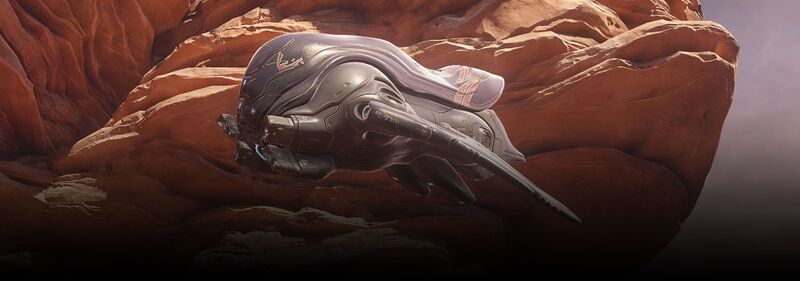
| « | The Banshee is easily the Covenant’s most common support aircraft, offering extremely high maneuverability alongside an impressive armament. —
|
» |


Banshee
Support Aircraft
Manufacturer: Assembly Forges, Lodam Armory
Crew: 1 pilot
Primary Armament: DEML-AW (2), Plasma Bolt/Diffused (Class-2)
Secondary Armament: HAAW/M, Heavy Fuel Rod (Class-3)
Length: 22.8 ft (7 m)
Width: 24.7 ft (7.5 m)
Height: 11.5 ft (3.5 m)
Weight: 2.5 tons (2.3 tonnes)
Summary
The Banshee is easily the most common support aircraft employed by the Covenant and were deployed in the hundreds of thousands during the course of the Human-Covenant War. The Banshee’s ease of operation, reliability, maneuverability, and impressive armament makes it even more valuable to the various warlords who vie for power in the ruins of the once-mighty Covenant empire.
History
The Banshee has had a long history of usage not just within the Covenant, but also by the ancient Sangheili fleets who explored the stars decades before the arrival of the San’Shyuum. Though refined over the ages, these early Banshees would still be recognizable into the modern day, as they are all patterned on the ‘sKelln, a voracious and cunning aerial predator that stalks the skies on Sanghelios.
Design
The Banshee family contains a host of variants, several of which have been captured and investigated at length by ONI and the UNSC in hopes to learn more about Covenant technology. Design variation can in some cases be attributed to specialized functionality while others represent the sheer aesthetic choice of whoever was commissioning the craft. While a handful of visually-distinct models have been encountered in the field, analysis of Covenant records procured post-war have referenced dozens of different Banshee variants that have seen implementation in some fashion. Several variants have no currently documented encounters with the UNSC but are described in Covenant and Sangheili manifests.
Unusual Variants
Ancient patterns
The earliest Sangheili Banshees were called Uztet’sKelln, in honor of the ‘sKelln. Though unreliable and slow compared to its more modern descendants, the Uztet’sKelln’s smooth, elegantly contoured canopy and twin impulse-drive design informed the shape of all Banshees that followed. Particularly ancient Banshees are often tasked with ceremonial roles and given elaborate ornamentation, such as the Banshees dedicated to the Sangheili Honor Guard, or those commissioned directly by various Kaidons as personal transports.
Known to ONI only from analysis of Covenant operational records, the enigmatic QezoY’asabu (”Obsidian Wing”) appears to be an ancient Banshee built primarily for stealth operations, with integral active camouflage systems and sensor bafflers of extraordinary refinement. What little evidence exists indicates it was employed by Covenant special forces for delicate inquisitorial operations.
Amphibious attack & escort Though rarely encountered by UNSC forces, amphibious Banshee variants have also been commissioned throughout the Covenant’s history to provide multi-environment security for oceanic Covenant installations and deep-sea artifact retrieval missions.
Minor Variants
T-26A: The T-26A was encountered by UNSC on many occasions, and was the first Banshee to be type-classified by ONI analysts following the attack on Harvest.
T-26B: A more advanced pattern of Banshee that languished in Covenant peacetime service until the war against humanity began to strain older stocks of Banshees, the T-26B began to see widespread use from 2550 on. Manufactured throughout the Covenant, large numbers of new T-26B’s were commissioned by Jul ‘Mdama while he built up his forces at Requiem
T-26AZ: Though the significance of its design is opaque to human analysts, it is known that the T-26AZ was only found in use by select artifact-hunting fleets associated with the Covenant ecclesiarchy, including Sesa ‘Refumee’s contingent deployed to the Forerunner gas mine at Threshold.
T-26BZ: The ordained variation of the T-26B is thought to have been the chosen model of Loka ‘Bandolee, whose soldiers were initially deployed alongside those of Sesa ‘Refumee to the Threshold gas mines.
T-26C: The T-26C was encountered during humanity’s last stand on Earth and among Truth’s forces on Installation 00.
T-27 Exoatmospheric Multirole Fighter: T-27 Banshee Fighters, sometimes referred to as “Space Banshees,” are exoatmospheric craft utilized to screen larger fighters and bombers in fleet engagements. Considered expendable, the Covenant utilized these fighters to overwhelm enemies by sheer numbers.
T-54: Combat flyers have been a staple in the Elite warfare for millennia, and the Hesduros-pattern T-54 Banshee harkens back to earlier designs that once dominated the Sanghelios skies. Freed from the design shackles of conservative San’Shyuum bureaucrats, the Banshee has been updated with numerous improvements, including an integral energy shield.
Brute Prowler[modifier | modifier le wikicode]
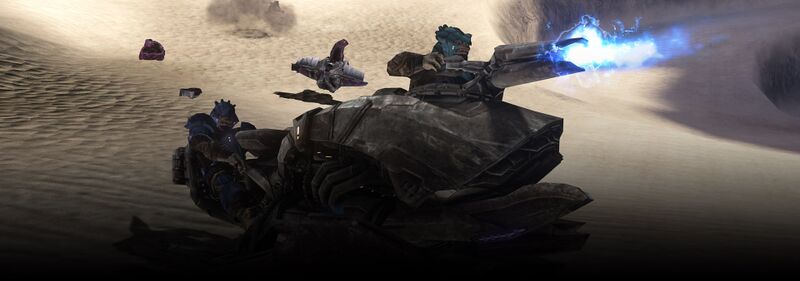
| « | The Brute Prowler is a Jiralhanae-designed infantry fighting vehicle that was deployed in the final months of the Covenant War. —
|
» |


Brute Prowler
Type-52 Infantry Support Vehicle
Manufacturer: Sacred Promissory
Crew: 1 Driver + 1 Gunner + 2 Passengers
Primary Armament: Light Plasma Cannon
Maximum Speed: 58mph (92km/h)
Length: 23.3ft (7.1m)
Width: 13.8ft (4.2m)
Height: 9.6ft (2.9m)
Weight: 7.3 tons (6.6 tonnes)
Summary
The Brute Prowler - like most other Jiralhanae weapons and vehicles – is a composite design that marries Covenant technology to an indigenous design. The exact configuration of the original Brute vehicle is unknown, though theories range from an arctic fast-attack vehicle to naval patrol boat.
Armament
Brute Prowlers are armed with a single pintle-mounted light plasma cannon of dubious utility. Brute drivers preferred to use the vehicle’s armored prow as the primary weapon, cutting down enemy infantry and ramming into armored vehicles before unloading its passengers. Manufacturer Sacred Promissory
Condor (original)[modifier | modifier le wikicode]
| « | The Condor is long-range aerospace transport vessel equipped with a slipspace drive and developed by Misriah Armory. —
|
» |
Indisponible.
Condor (mise à jour)[modifier | modifier le wikicode]

| « | The Condor is long-range aerospace transport vessel equipped with a slipspace drive and developed by Misriah Armory. —
|
» |


Condor
D81-Long Range Transport
Manufacturer: Misriah Armory
Crew: 15-20 personnel
FTL-Capability: Short to Mid-range
Length: 140.4ft (42.8m)
Width: 82.6ft (25.2m)
Height: 42.5ft (13m)
Summary
The Condor is long-range transport vessel developed by Misriah Armory. While it shares visual similarities between the more ubiquitous D79 Pelican variants, the functionality of the D81-LRT Condor overlaps more with heavy materiel and equipment deployment vessels such as the D96-TCE Albatross and D82-EST Darter. What truly sets the Condor apart though, is its faster-than-light (FTL) capabilities, allowing for a much longer range of operation and no need for a larger spacecraft or capital ship to deploy from.
Operational History
While the Condor’s abilities are nearly unmatched among its peers, the narrow range of ideal mission parameters combined with high development and operational costs eventually saw use of the Condor decline in the military sector. However, while small FTL-capable vessels like this eventually faded from service in the UNSC, the Condor saw renewed interest in the civilian sector, where it proved ideal in low-volume, high-profit freighting.
Outer Colonies looking to further solidify their autonomy from the Unified Earth Government after the war leveraged the Condor’s FTL capabilities. With the Condor, the colonies could cross long distances to scout possible trade routes and establish diplomatic relationships without interference of the UNSC and their draconian controls on intersystem commerce.
Technical Details
The Condor is built using an elongated Pelican dropship fuselage (the D79 for current D81 model), and leverages most of original aircraft's flight systems, engines, and structural spars. The original tail thrusters are removed and replaced with the Mission Package, which contains a slipspace drive and four engine pods. Aside from the slipspace drive, the Condor maintains roughly 95% parts commonality with the original Pelican. For this reason, the Condor is often referred to as the "Fat Pelican" and "SuperPelican" by users.
While compact slipspace drives have historically been fantastically expensive and temperamental (particularly those sold to civilians), post-War advances have reduced commercially available unit costs by orders of magnitude. Maintenance remains a thorny problem, however, and the Condor's slipspace drive is rated for only five trips before needing comprehensive retuning, and eight trips between full rebuilds.
D81 Condors are generally unarmed, with a multi-sensor package replacing the military Pelican's rotary autocannons. However, the Condor does retain the original six hardpoints on the wings, and canny colonial operators have created custom fire control systems to tie these into the civilian controls.
Variants
D80: Original Condor - model built on the D77C Pelican body. It's slipspace drive capabilities were limited, with transit times roughly double that of larger, more efficient, systems in use at the time.
D81: Post-War Condor - using more efficient slipspace drive and excess military D79 Pelican frames. The upper cockpit, which housed the weapons/sensor operator is often either stripped out or converted into VIP seating.
D81WP: The WP (Weapon Package) variant is offered by Misriah Armory for sale to the UNSC, bonded paramilitary units, and planetary security forces. This variant retains the D79's dual autocannon turret.
U81: Unofficial designation for refit Condors used by ONI for reconnaissance and surveillance. Outwardly indistinguishable from civilian craft, they incorporate an advanced electronic warfare suite, extensive passive sensor array, and military-grade slipspace drive. Occasionally classed as a "subprowler" due to its covert mission profile, despite lacking passive cloaking or sensor baffling coatings.
Colonial Tug[modifier | modifier le wikicode]

| « | The Colonial Tug is an interplanetary transport vessels primarily used for the transport of civilian goods and cargo. —
|
» |
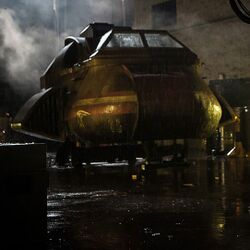
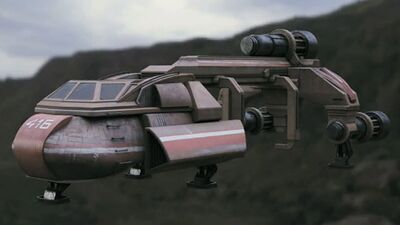
Colonial Tug
Bactrian-class Freighter
Manufacturer: Oros Trading Company
Crew: 2 Personal
FTL-Capabilities: Mid-range
Security: Biometric Ignition
Summary
The Colonial Tug is one of a broad range of interplanetary transport vessels primarily utilized in the freightage of cargo between colonies. This variant is most prevalent on the human colony world of Aleria and represents a useful but widely-antiquated design. These particular tugs represent an older model of craft, lacking more modern technological advancements such as trans-optic scaling, an augmented sighting system that assists in navigation controls.
Tugs like these were not without their own security measures, including the employment of a biometric ignition to satisfy the requirements of the cooperative protocol, a two-pilot system on mining and transport tugs. Freighter companies found that two-seater transports had the lowest risk of all mining units, leading to an influx of two-seat tugs like the Bactrian-class freighter and the increased use of biometric ignitions. The cooperative protocol is designed to mitigate certain risks in operation as only a tug’s specific operators would be able to turn its engines.
Chopper[modifier | modifier le wikicode]

| « | Originally designed for farming purposes, the Brutes reconfigured the Chopper, transforming the machine into a swift and violent assault vehicle. —
|
» |


Chopper
Type-25 Rapid Assault Vehicle
Manufacturer: Sacred Promissory
Crew: 1 Operator
Primary Armament: 35mm Autocannon (4)
Secondary Armament: Ramming Targe
Maximum Speed: 74 kilometers per hour (46 mph)
Length: 20.9ft (6.4m)
Height: 9.3ft (2.8m)
Weight: 1.1 tons (1 tonne)
Summary
Originally a human farming instrument reconfigured by Huragok for peaceful purposes, the Jiralhanae quickly transformed the vehicle into a swift assault craft. Thousands of the vehicles remain in service with Brute packs and rebel groups of various species and affiliations.
Designed during the Jiralhanae's first encounter with humans, the Jiralhanae machine known as the Chopper serves as a rapid assault vehicle, providing infantry ground support and augmenting existing armor. Its size, shape, speed, and overall maneuverability make it incredibly effective in a variety of terrains and environments, whether they be expansive landscapes of looming sand dunes or the narrow confines of a human city.
Design
Choppers constructed by High Charity made full use of advanced nanofabrication facilities, though Brute psychological peculiarities and extremely poor maintenance programs required that the final products were necessarily crude in appearance and some aspects of their function. Those manufactured by Brutes themselves were often composed of salvaged human and Covenant equipment, marrying damaged Ghost boosted-gravity drives with human battleplate in a savage composite.
History
Shortly before the Brute cruiser Rapid Conversion made contact with humanity on the planet Harvest, an accident damaged one of the Spirit dropships onboard. A Covenant Huragok, Lighter Than Some, seized this opportunity to atone for a past misdeed he committed against the humans. Since the planet was agrarian, the creature used parts from the Spirit to create a pair of farming vehicles – akin to Harvest’s JOTUN tractors – as a gift for the humans. However, believing these to be combat vehicles, the Brutes affixed weapons to the machines and deployed them against the very same humans for whom the vehicles were intended. After Harvest, the Brutes integrated several features more reasonable for a rapid assault vehicle, including twin pairs heavy spike cannons for ranged combat.
Throughout the war with humanity, the Brutes continued to intermittently manufacture Choppers until 2552, when the bulk of the vehicle’s production were moved to High Charity’s Sacred Promissory in the leadup to the Brute’s coup d'état against the Covenant’s military leaders, the Elites. These secret forges produced massive numbers of these crude machines until High Charity’s destruction following the Great Schism. The resulting loss of the Sacred Promissory did not end the Chopper’s production, however, as scattered worlds under the thumb of Brute warlords continue to assemble these vehicles for independent raiding packs and Banished warhosts alike, ensuring that they will continue to be an unwelcome sight on human worlds for many years to come.
Cyclops[modifier | modifier le wikicode]

| « | The Cyclops is a one-man bipedal vehicle designed for combat engineering and dock work aboard UNSC vessels. —
|
» |


Cyclops
HRUNTING Mark III [B] Exoskeleton
Manufacturer: Weapons Research (T12a)
Maximum Speed: 30 mph (48.3 km/k)
Width: 11.7ft (3.6m)
Height: 14.2ft (4.3m)
Summary
The Cyclops is a bipedal machine with a reinforced cockpit as its “head.” The two three-fingered hands are surprisingly dexterous, and the suit is strong enough to lift heavy cargo pallets and maneuver crippled armored vehicles. Its large feet help mitigate the suit’s ground pressure, but the Cyclops is a surprisingly lightweight design considering its size - a testament to the advanced structural materials developed by Algolis engineers and scientists.
The Cyclops’ operator sits in a control web within the torso, encased in a smaller active-impedance haptic interface exoskeleton that drives the larger vehicle’s movements. In effect, the suit mimes the actions of the operator and provides force feedback to make “driving” the Cyclops feel more natural and an extension of the user’s body.
Armament
The standard Cyclops does not have any built-in armaments - though skilled operators can perform surprising feats of dexterity and use the suit’s arms as devastating close-combat weapons.
Major Variants:
The basic Cyclops is effectively a strength-enhancing suit for its human operator, but its ease of use and load carrying capacity made it useful in a number of different fields.
Mark III [A]: Initial prototype using neural interface controls. The sealed canopy used an armored carapace visually similar to that utilized in the later MJOLNIR EVA variants.
Mark III [B]: Unarmed production version.
Mark III [B-II]: Unofficial nomenclature for [B] exoskeletons which features redesigned feet and a more robust, sealed cockpit. Many also use alternate power-packs that replace the expensive fusion generator with hydrogen-burning turbines or high-density power cells.
Mark III [B1]: Upgraded [B] models produced by Hannibal Weapon Systems with composite armor plating and hardpoints for weapon installation. These refits proved popular with paramilitary security forces in many Earth cities.
Mark III [M1]: Armed variant produced by Lethbridge Industrial currently undergoing field trials with the UNSC Army. These units are multi-purpose assault platforms with shoulder heavy weapon hardpoints and Titanium-A plating.
Minor Variants:
There are no official categorizations for minor Cyclops variants, but most follow common themes in terms of their loadout and scope of modification. In addition to alterations to enhance their suitability in specific climates, the following are examples of Cyclops used in 2558:
Peacekeeper: Popular with police SWAT teams in Earth’s megacities, these Mark III [A1] units are usually equipped with a large riot shield and a low-pressure autocannon that can fire a variety of riot-control munitions. Most were destroyed after being pressed into active combat duty.
Protector: Deployed in high-threat civil rescue missions, Protector units (usually older B-II units) are used by firefighters and medical response teams for deployment in situations where larger vehicles cannot fit, and unprotected workers would risk death. A typical configuration mounts a large tank of fire-retardant foam and a high-pressure projector, and a high-torque gripping arm for ripping apart mangled vehicles to get at trapped occupants or breaking the reinforced walls seen in many arcologies.
Breaker: These Cyclops frames mount specialized tools for shipbreaking and construction, which may include high-power plasma-cutters, hydraulic rams, or assorted cutting blades. Wreckers employed by the UNSC and contractors are vacuum sealed and kept busy slicing up shattered ship hulks and stations that remain in orbit around Earth or excavating half-melted buildings on the vitrified surfaces of former colonies.
Hazops: Cyclops with biolab-grade environmental sealing and a heavy flamethrower are sometimes assigned as support vehicles to Spartan assessment and containment teams at Forerunner sites which may house Flood samples. Unfortunately, it is often necessary to destroy these suits at the end of successful containment missions, as properly cleaning every nook and crevice for traces of Flood spores is prohibitively challenging. A worst-case scenario - so far explored only in simulations - is one in which the operator is infected by the Flood and FSC-based biomass further augments the existing exoskeleton armature.
Covenant Cruiser[modifier | modifier le wikicode]

| « | Covenant cruisers are midsize capital ships capable of conducting independent naval operations. —
|
» |
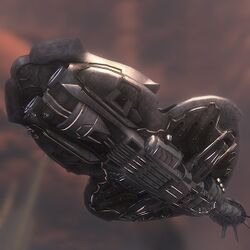

Covenant Cruiser
Covenant Cruiser
Affiliation: Covenant
Length: Varies based on class
Role: Attack, Interdiction, Occupation, Patrol
Primary Armament: Ventral Cleansing Beam
Secondary Armament: Anterior Plasma Cannons
Tertiary Armament: Point Laser Defense
Summary
Since the very beginning, the Covenant's primary mode of intergalactic transportation and means of enforcing the Prophet’s dictates has consistently been the cruiser. They were manufactured in vast quantities, easily surpassing the numbers of any other known Covenant vessel.
Architecture
Covenant cruisers follows the typical structure of all Covenant ships - a sleek hull with sweeping contours and nearly perfect symmetry, reminiscent of large marine animals found on Sangheili colony worlds. Along its undercarriage are two to four hangar bays aft of a large gravity lift platform which can be detached and lowered onto a planet's surface. The vessel then generates a vertical gravity beam for conveyance of infantry, supplies, and assets. Modular bays within the ship can be configured as engineering, medical, armory, barracks, and religious facilities, interconnected by a network of narrow corridors and lifts. Buried deep within the vessel's heart is the command deck, a large room with a centralized bridge platform typically occupied by only the highest-ranking officers.
Variants
The Covenant fielded at least four distinct classes of cruiser during the war with humanity, and while each looks strikingly similar, their size and firepower can vary wildly.
CCS-class Battlecruiser
The Covenant’s most prominent cruiser design. They are ideal for troop and vehicle deployment during ground engagements, as well as participating in ship-to-ship naval combat. In the tumultuous years after the war, many battlecruisers fell under the control of Kig-Yar scavengers and Sangheili warlords.
Role: Attack, occupation Length: 5,847ft (1,782m)
CRS-class Light Cruiser
While the CRS-class light cruiser may appear to be a smaller, weaker version of the battlecruiser, it is still more than a match for most UNSC vessels. Rarely seen, light cruisers have been described by UNSC forces as looking like “luminous manta rays.”
Role: Support, interdiction Length: 984ft (300m)
RCS-class Armored Cruiser
Developed when shielding technology was far more limited, the RCS-class ships lacked the firepower or robustness of the later CCS-class. However, they took on an important role in the various Covenant splinter fleets that formed after the Great Schism.
Role: Patrol, occupation Length: 6,562ft (2,000m)
ORS-class Heavy Cruiser
Heavy cruisers pack plenty of offensive punch by way of their impressive plasma torpedo array and heavy plasma lance emitters. After the Great Schism, these ships proved invaluable to warlords who could acquire and crew them.
Role: Survey, command Length: 9,843ft (3,000m)
Covenant Destroyer[modifier | modifier le wikicode]

| « | The Covenant destroyer is a vessel intended specifically for pursuit and attack, although it can and has been used in lieu of cruisers and carriers for occupation purposes. —
|
» |


Covenant Destroyer
RPV, CPV
Affiliation: Covenant
Role: Reconnaissance and Attack
Length: 4,921ft - 5,459ft (1,500m -1,664m)
Beam: 3,993ft - 4,429ft (1,217m - 1,350m)
Summary
Destroyers within the Covenant naval fleets typically fall into one of two classes: RPV and CPV, though there are others serving in a lesser capacity. RPV-class vessels are usually sent in advance of an invasion and are used for escort on reconnaissance missions. They are smaller, but generally carry the same armament as CPV-class destroyers, which are predominantly designed to crush an opponent’s resistance and initiate the Covenant’s scorched earth policy of glassing their enemy’s unfortunate worlds.
During Admiral Cole’s five-year campaign to retake Harvest, the Covenant used CPV-class destroyers in their effort to eliminate Harvest’s human presence. This became commonplace in many of the invasions they initiated during the three-decade long war.
An RPV-class destroyer escorted two Covenant frigates and a carrier in a brief skirmish above Sigma Octanus IV. This battle preceded the larger conflict, which saw one of only a few human naval victories during the Covenant War.
Variants
There are two main variants of the Destroyer.
RPV-class Light Destroyer: Light destroyers are used primarily for reconnaissance missions and the pursuit of escaping enemy vessels.
CPV-class Heavy Destroyer: Heavy destroyers are deployed for direct attacks on enemy targets. They are an ideal ship for heavy combat situations.
Covenant Corvette[modifier | modifier le wikicode]

| « | Covenant corvettes are fast, sleek support vessels used for reconnaissance, fleet escort, troop transport, and bombardment of surface targets. —
|
» |

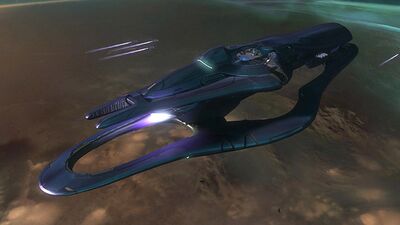
Covenant Corvette
DAV, SDV
Affiliation: Covenant
Role: Stealth, intelligence gathering, escort
Primary Armament: Plasma cannons
Length: 1,590ft -3,135ft (956m - 485m)
Beam: 985ft - 1,309ft (399m - 202m)
Summary
Used for a wide variety of functions, Covenant corvettes historically took part in surveying of Forerunner reliquary sites and deployment of small artifact-retrieval teams to evade any active defensive measures. In the war against the humans they were utilized in front-line combat roles as well as long-range reconnaissance of potential naval staging areas and colonies. In both roles the Covenant corvette’s relatively small size, maneuverability, and low sensor signature allow them to remain undetected except at close range.
Variants
There are two known variants of the Covenant corvette.
DAV-class Light Corvette: The light corvette is used primarily for stealth missions and covert information gathering, including the deployment and retrieval of Ranger teams.
SDV-class Heavy Corvette: Heavy corvettes rarely engage in ship-to-ship combat, though they are capable of engaging human frigates on more-or-less even terms, if pressed. Instead they typically escort larger capital ships, deploy fighters in fleet engagements, and screen support ships from human fast-attack craft.
Dreadnought[modifier | modifier le wikicode]

| « | The Forerunner dreadnought, also referred to as the keyship, played a vital role in conserving life in the galaxy. —
|
» |

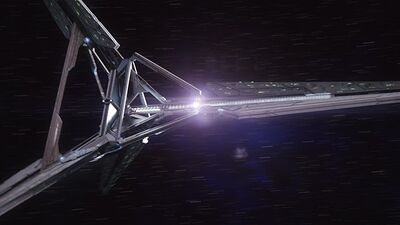
Dreadnought
Keyship
Origin: Forerunnner
Height (in flight): 35,349ft (10,774m)
Beam (in flight): 40,817ft (12,441m)
Length (in flight): 43,046ft (13,120m)
Summary
Generally referred to as the Dreadnought due to its formidable size and firepower, this immense Forerunner keyship supported the Librarian during the Conservation Measure, transporting species to the Ark for indexing and archival until after the Halo rings fired. Once the Flood was defeated, the dreadnought assisted in re-seeding the Milky Way using hidden slipspace portals placed throughout the galaxy.
However, long years after the Conservation Measure had drawn to a close, an enduring shard of Mendicant Bias would awaken on the Ark and access the ship, hoping to utilize it in an effort to reach humanity. Unfortunately, the ancilla’s journey would be cut short, and the vessel crashed onto the San’Shyuum homeworld of Janjur Qom - its impact creating an enormous sea which would come to be called the Great Apothtea. Many years later the San’Shyuum would regard the ship as a religious artifact, and eventually, a radical sect of San’Shyuum took it into space in an effort to find other Forerunner artifacts.
During their travels, the San’Shyuum encountered the Sangheili species on the world of Ulgethon, and after a series of devastating battles across a number of colony worlds, the Covenant was forged. The ancient Forerunner dreadnought, which still held Mendicant Bias’ dormant shard, was installed at the heart of the Holy City of High Charity. Though this effectively decommissioned the vessel as a weapon of war, it went on to provide power to the entire station and acted as a central point of worship for the Covenant. In 2552, the High Prophet of Truth abandoned High Charity, taking the dreadnought with him and leading a vast Covenant fleet to Earth. On Earth, the same dreadnought was used to activate a long-dormant portal, propelling Truth and his forces to the Ark.
Falcon[modifier | modifier le wikicode]

| « | The Falcon is a versatile, multipurpose utility helicopter used by UNSC Army units. —
|
» |


Falcon
UH-144A
Manufacturer: Misriah Armory
Entered Service: 2497
Crew: 1 Pilot + 5 Passengers
Maximum Speed: 184mph (296 Km/H)
Length: 37.5ft (11.4m)
Width: 32.8ft (10m)
Height: 13.6ft (4.1m)
Weight: 15.3 Tons (13.9 Tonnes)
Summary
The Falcon is a versatile, transverse-rotor multipurpose utility helicopter that entered service in 2497, though it was only truly common with garrison forces on inner colony worlds. Capable of being fitted with a range of armaments, the Falcon proved to be an economical alternative to the larger Pelican for short-range troop deployment by UNSC Army units.
The Falcon’s frame is composed of a single elongated fuselage with a narrow, single-man cockpit and a large rear cabin, flanked by small wings. Each wing ends in an engine pod and rotors. Though the rotors are powerful and capable of lifting a fully-loaded Falcon, two dorsal-routed jet turbines provide most of its thrust during forward flight.
Armament
Falcons utilize a M638 Autocannon installed in a nose turret, which can provide suppressive fire when extracting or deploying personnel. The emplacements installed on the flexible mount hardpoints on either side of the open cabin are at the discretion of the Falcon’s crew, though most utilize either a pair of M247H Heavy Machine Guns or M460 Automatic Grenade Launchers.
Major Variants:
UH-144A: Designation for Falcon's fitted with dual grenade launchers.
UH-144S: Designation for Falcon's fitted with dual heavy machine guns.
Ghost[modifier | modifier le wikicode]

| « | The Ghost is the Covenant’s premiere scouting vehicle and has been a staple of their ground forces in a number of variations. —
|
» |


Ghost
T-32 Rapid Attack Vehicle
Manufacturer: Iruiru Armory
First Observed: 2526
Crew: 1 operator
Length: 13.8ft (4.2m)
Width: 12.6ft (3.9m)
Height: 6ft (1.8m)
Weight: 1,232.3lbs (559.1kg)
Maximum Speed: 82mph (132km/h)
Summary
Fast and maneuverable, the Ghost could be used for everything from deep reconnaissance to assault runs. A testament to its field success, the T-32 has remained largely unchanged for centuries. This perfected design utilizes a single-mount rear-positioned seat and twin-linked plasma cannons; it maintains excellent mobility, regardless of the terrain it finds itself deployed in.
The T-32 Ghost’s long and established history anti-infantry firepower within the Covenant clearly boasts the success of its operational viability and the ubiquity of its use. Its remarkable mobility, excellent speed, and effective firepower are only offset by the open cockpit, which naturally places the operator at risk--though ONI believes this was intentional, and reflects a quirk of Sangheili psychology. The Covenant used the Ghost primarily as a scouting or reconnaissance vehicle, sending it behind enemy lines to track and monitor an adversary’s movement. It can also be used to engage enemies with reasonably large infantry numbers and even well-armed, light vehicles.
Grizzly[modifier | modifier le wikicode]
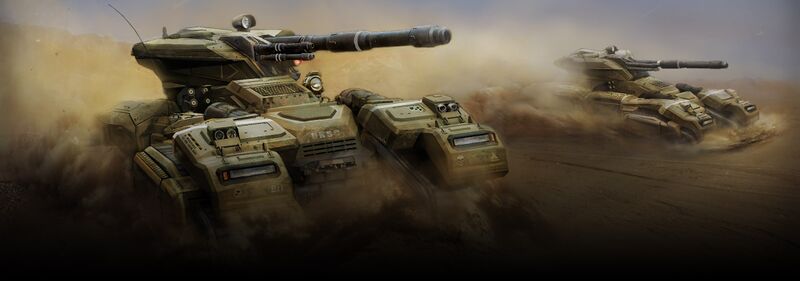
| « | The Grizzly is employed in combat situations that require overwhelming firepower and near-invulnerability. —
|
» |


Grizzly
M850 Main Battle Tank
Manufacturer: Chalybs Defense Solutions
Entered Service: 2509
Crew: 1 Operator + 1 Gunner
Maximum Speed: 43 Mph (69 km/h)
Length: 40.2ft (12.3m)
Width: 27.5ft (8.4m)
Height: 23.6ft (7.2m)
Weight: 71.4 Tons (64.8 Tonnes)
Summary
The Grizzly is the heaviest armored vehicle in the UNSC inventory, employed most often in engagements that demand devastating firepower and near-impervious design in a single mobile package. Its exceptionally resilient armor can withstand multiple strikes by heavy plasma cannons, and can then unilaterally retaliate with dual large-bore cannons, breaking through the target’s shields and hull in a single salvo.
Armament
The most notable feature of the M850 Grizzly is the dual M310 120mm smoothbore cannons installed in the full-rotation turret. Jokingly referred to as the “main funs” by crews, the cannons are capable of a surprisingly high rate of fire with its innovative autoloading system that uses the recoil of one cannon to speed the loading of the other.
History
The origins of the Grizzly are shrouded due to maneuverings by many competing bureaucratic and corporate interests within the UNSC at the time of its development. Widely derided as a white elephant, the specialized battle tank quickly found a niche with Army and Marine units despite initial skepticism and the logistical challenges of transporting it. The Grizzly proved invaluable both as an anti-armor vehicle and a mobile fortress that could drive straight into the heart of insurrection positions and outgun any rebel armored vehicle (including captured Scorpions).
The beginning of the Covenant War cemented the Grizzly’s reputation as the bane of enemy armored vehicles. On the open field the Grizzly was practically unstoppable, and often forced the Covenant to deploy naval assets in order to decisively end the threat that even one or two tanks could cause to their staging areas and supply columns.
Though popular and effective, the size of the Grizzly caused significant issues after the conclusion of the war, as remaining heavy-lift spacecraft were tasked for high-priority reconstruction and few threats couldn’t be countered with the lighter, cheaper Scorpion. In other words, while its performance was lauded, logistical requirements were simply insurmountable given post-war realities. That said, several Army units maintained Grizzly units for planetary defense (including the garrison on Draetheus V) for years later.
Indulgence of Conviction[modifier | modifier le wikicode]

| « | The Indulgence of Conviction was a Covenant battlecruiser that the Flood used in an attempt to infect Earth. —
|
» |


Indulgence of Conviction
CCS-class
Manufacturer: Assembly Forges
Primary Armament: Ventral Cleansing Beam
Secondary Armament: Anterior Plasma Cannons
Tertiary Armament: Point Laser Defense
Length: 5,847ft (1,782m)
Beam: 2,827ft (862m)
Destroyed: 2552 (Battle of Voi)
Summary
The Indulgence of Conviction was a Covenant CCS-class battlecruiser captured by the Flood at the end of the Human-Covenant War. Its offensive and defensive abilities, combined with a large personnel and equipment capacity, made it ideal for troop and vehicle deployment during ground engagements, as well as ship-to-ship naval combat.
Battle of Voi
The Flood successfully captured the Indulgence of Conviction during the Battle of Installation 05. After the parasite had infected the ship's crew, the Flood wasted no time in breaking through the already overwhelmed Sangheili blockade. Setting its sights on the human homeworld, the ship crashed on Earth near the city of Voi and unleashed its parasitic cargo. The Master Chief John-117 and the Arbiter Thel 'Vadam made the decision to detonate the ship’s reactors to prevent the Flood from spreading further. The plan was halted when John-117 learned there was a chance that Cortana was aboard the vessel.
He entered the ship and found, not Cortana, but a message from her with vital information on a way to defeat the Flood. The area around the ship was evacuated and the Fleet of Retribution selectively glassed the contaminated area, destroying both the remains of the ship and the Flood.
Kestrel[modifier | modifier le wikicode]

| « | The Kestrel is a well-armed, high-mobility platform designed for nap-of-the earth combat operations. —
|
» |


Kestrel
AV-30 Light Assault VTOL
Manufacturer: Misriah Armory
Crew: 1 operator
Role: Fast Attack
Summary
The AV-30 Kestrel is technically classified as a Light Assault VTOL (Vertical Take-Off and Landing), though in most cases it operates as a well-armed, high-mobility combat hovercraft. The Kestrel is propelled by three independently powered ducted fans that allow the vehicle to deftly navigate surprisingly narrow spaces and engage in acrobatic aerial maneuvers.
Armament
The standard production model Kestrel is armed with twin GAU-10/A heavy autocannons, though experimental models have also included a pair of M302 rocket pods.
Development
The Office of Naval Intelligence invests heavily in weapons prototyping, although most new designs never make it past the theoretical/modeling stage. Every once in a while a new weapon system proves to have the perfect mix of lethality and survivability, and the Kestrel is a perfect example of human ingenuity pushing the war effort in the right direction. Starting with several competing design philosophies encompassing various shapes, armament combinations, and turbine layouts, ONI skunkworks engineers eventually settled on a final design that was handed off to Misriah Armory for serial production.
Kraken[modifier | modifier le wikicode]

| « | Capable of leveling enemy defenses and subduing entrenched fortifications in mere seconds, the Kraken is the most powerful siege engine utilized by the Covenant. —
|
» |


Kraken
T-55 Ultra-Heavy Siege Tower
Manufacturer: Unknown
First Encountered: 2555
Crew: 10 crew + 250 passengers
Summary
The Kraken is generally deployed by a capital ship from a suborbital location, dropping quickly to the surface of a world while moving into an effective position. Once in place, the siege tower can relentlessly beset an enemy site through the firing of stationary weapon emplacements, the deployment of individual strike forces, or even physically ripping apart an opponent’s fortified structures with its three grapplers.
Design
The Kraken is an ultra-heavy siege tower, a massive Covenant sky fortress with three powerful grappler arms capable of physically crushing and moving mountain-sized objects. The carapace’s main assault platform is augmented with stationary weapons, aircraft, and infantry, and is used as a staging site for localized incursions, allowing it to roll through enemy defenses like a tsunami.
History
Some human records indicate that the Kraken may have been encountered early in the war with the Covenant, but none survived to confirm it. Only after the war, under the direction of Jul ‘Mdama, did the Covenant leverage Krakens with some level of regularity. It’s commonly held that these siege towers were originally based on a variant of Forerunner Sentinels used during their war with the Flood, discovered in a reliquary of mothballed ordnance before being created by the Covenant.
Resurgence
In his effort to return the Covenant to prominence, Jul ‘Mdama managed to secure several weapons caches belonging to the old guard. This included a number of Krakens. Although early on he utilized them sparingly, wanting to avoid tipping his hand, in October 2558, the Covenant deployed them en masse: one to Kamchatka and another to Sanghelios. This aggressive move would mark the first real engagement the UNSC would have with these incredibly destructive machines, though it would not be the last.
Mongoose (original)[modifier | modifier le wikicode]

| « | The Mongoose is a light all-terrain ground reconnaissance vehicle used by the UNSC and developed by AMG Transport Dynamics. —
|
» |


Mongoose
M274 Ultra-Light All-Terrain Vehicle
Manufacturer: AMG Transport Dynamics
Crew: 2
Length: 10.6 ft (3.2m)
Width: 6.1 ft (1.8m)
Height: 4.9 ft (1.5m)
Summary
The Mongoose is a light all-terrain vehicle used by the UNSC. AMG Transport Dynamics began manufacturing light-armored ATVs in 2483, and have since generated seventeen impressive versions of the Mongoose. Their most recent edition is the M274 Ultra-Light All-Terrain Vehicle. The primary benefit of the Mongoose is not speed, but rather maneuverability and optimized control over difficult terrain and challenging environmental conditions.
Common practice among Spartans -- though not advised by UNSC safety protocols -- is carrying a passenger standing on the bumper plate. With a well-armed passenger, the Mongoose becomes formidable in combat with impressive firepower balancing the ATV's speed and maneuverability. Additionally, there is an armed variant of the Mongoose, the M274-M nicknamed the "Gungoose,” which mounts twin M67 SMGs.
Mongoose (mise à jour)[modifier | modifier le wikicode]

| « | The Mongoose is an all-terrain quad bike popular both on the civilian market and within the UNSC. —
|
» |


Mongoose
M290 All-Terrain Vehicle
Manufacturer: AMG Transport Dynamics
Crew: 1 Driver + 1 Passenger
Length: 11.5ft (3.5m)
Width: 6.6ft (2m)
Height: 5.7ft (1.7m)
Summary
Lovingly dubbed the “mothergoose” by frontline infantry men and women due to its increased size over the M274, the M290 is the latest military version of the popular ‘Mongoose’ all-terrain vehicle produced by AMG Transport Dynamics since 2483. Both the civilian and military versions are available with a variety of upgrade packages, including armored body panels, improved suspension systems, and alternate engines. The civilian version is not rated to carry Spartans without risking damage to the frame.
Most Mongoose ATVs are not fitted with weapons, though an armed passenger can be carried on the rear-facing seat to provide fire support.
Variants
M290-M: The M290-M, semi-officially designated the ‘Gungoose’, is fitted with two grenade launchers.
M274-M: The previous generation’s “Gungoose” variant, the smaller-framed M274-M is outfitted with twin M67 light anti-infantry weapons.
Mantis[modifier | modifier le wikicode]

| « | The Mantis is a heavy combat walker used by the UNSC. —
|
» |


Mantis
HRUNTING/YGGDRASIL Mark IX Armor Defense System
Manufacturer: Materials Group
Entered Service: 2403
Crew: 1 pilot
Maximum Speed: 27-34.5mph (43.5-55.5km/h)
Length: 9.3ft (2.8m)
Width: 19ft (5.8m)
Height: 18.6ft (5.7m)
Weight: 5.7 tons (5.2 tonnes)
Summary
The Mantis is an all-environment bipedal walker used by the UNSC Army, Marine Corps, ONI direct action teams, and private security forces. An evolution of earlier HRUNTING exoskeletons and YGGDRASIL research, the Mantis also integrates many technologies created for MJOLNIR, notably a neural interface link, compact fusion power plant, and shield generator.
YGGDRASIL
Project YGGDRASIL was the umbrella name for initiatives aimed at reengineering strategically significant MJOLNIR technologies for mass production and systems integration into new and existing UNSC combat vehicles. These efforts met with mixed success during the Covenant War due to lack of engineers and high tier manufacturing facilities; it was only after the conflict ended that the full potential of YGGDRASIL was realized.
Armament
The standard Mantis weapon configuration consists of a M655 20mm rotary autocannon and six-chamber M5920 rocket launcher. The current Mantis does not have modular hardpoints to swap out weapons, though both the UNSC Army and Marine Corps have contracted Materials Group to produce a refit package to allow alternate loadouts.
Meridian 5-Alpha[modifier | modifier le wikicode]

| « | Once a proud symbol of human colonization, the ship is now a bastion of reclamation. —
|
» |


Meridian 5-Alpha
'
Type: Medium Cargo Transport
Class: Star Charter
Crew: 25
Summary
The last of Meridian’s colony support ships, generally known only as “Alpha,” this vessel has served as one of the primary sustaining resources for the moon’s salvaging effort. After the Covenant’s first strike in 2548, a handful of these support ships were moved to the far side of Hestia V for safety. Miraculously, local skirmishes kept the Covenant preoccupied across the system for nearly three years, but after the UNSC abandoned the colony in 2551, these ships were later summoned by Liang-Dortmund to help facilitate their work. Following the awakening of the Forerunner Guardian on Meridian in October of 2558, most of Alpha was rendered inoperable in the destruction.
ONI Prowler[modifier | modifier le wikicode]

| « | ONI Prowlers are UNSC stealth spacecraft used for strategic reconnaissance, surreptitious transport of high-value individuals, and covert observation. —
|
» |


ONI Prowler
Strategic Reconnaissance Vessel
Affiliation: Human
Classes: Winter, Razor, Eclipse, Sahara
Role: Stealth and Reconnaissance
Summary
ONI Prowlers are small (typically, corvette-sized) warships that minimize their signature through the use of low-observable design features, stealth systems, and low-profile sensor systems. Though not invisible they are difficult to detect, and even more difficult to categorize – most distort their unavoidable emissions to appear as low-threat vessels, wreckage, or even friendly vessels. Prowler captains are also highly trained in the use of concealment and deception, particularly in the use of planetary bodies to mask their presence and the deployment of drone networks to remain in concealment while conducting their missions.
Active Stealth Systems
Traditional prowlers rely on passive features to remain undetected, minimizing their thermal signature, radar cross section, and electronic emissions though careful design, consumables (such as heat sinks and deception jammers), and emissions baffling. The reverse-engineering of active camouflage systems and limited integration of Forerunner “baffler” sensor distortion technology simply enhanced the vessels inherent stealth capabilities, allowing the vessels to avoid or defeat detection techniques that the Covenant had developed during the War.
Subprowlers
An informal designation, subprowlers are stealthy smallcraft – often deployed by larger prowlers – that are used to infiltrate and exfiltrate personnel and cargo from planetary surfaces. Though designed with low-observable technologies, subprowlers also feature a host of electronic countermeasure and decoy capabilities that increase their survivability in the dangerous period when entering and exiting atmospheres, or when operating near advanced aerospace defenses.
ONI Acrisius[modifier | modifier le wikicode]

| « | Stowed aboard Argent Moon, the Acrisius was the classified site’s safety valve, a final means of escape in the event that any high profile ONI assets were threatened. —
|
» |
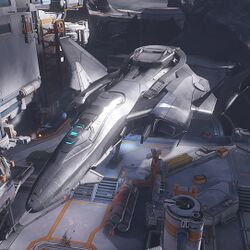
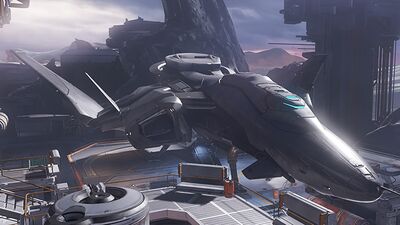
ONI Acrisius
Prowler
Class: Winter
Crew: 1 pilot, 1 weapons officer, 20 passengers
Primary Armament: M8545 ASW/AC 40mm MLA (2)
Secondary Armament: CBU-R68 Moray System
Summary
ONI Acrisius is a state-of-the-art Winter-class prowler, designed primarily for speed and stealth with the purpose of deep space reconnaissance. Fitted with a prototype slipspace drive, this ship could be quickly deployed in the far reaches of the galaxy to monitor ex-Covenant species and human insurgents, precautionary efforts to ensure humanity’s safety. For the Acrisius, however, these unique features were used to support ONI’s exfiltration protocol on the remote development site Argent Moon, where the prowler could be activated for swift departure.
Design
Similar in form and functionality to the classic Black Cat-class subprowlers used in the early 26th century, the Acrisius is a fully equipped Winter-class vessel, constructed with a smaller and more compact frame than other prowlers. Its aerodynamic armature, swooped back wings, and narrow cockpit resembles a number of UNSC fighters, intended for improved speed and versatility during atmospheric operations. Winter-class prowlers like Acrisius are lightly armed with twin machine guns and an aft-mounted mine-deployment system, but they are primarily designed for evasion and escape. Relying on incredibly advanced stealth system from scuppered Forerunner and Covenant technology, the prowler can remain completely hidden from both sight and sensors.
History
In the years following the war, ONI revisited a number of pre-Covenant prowler designs which focused on espionage and reconnaissance over combat. The Acrisius, and other Winter-class prowlers, arose for this production stem. When Argent Moon was constructed, Acrisius remained on the station for the full duration of the research site’s existence. Protocol dictated that if any high-profile ONI personnel were in danger, they were to utilize Acrisius to escape. This plan was not realized until well after the Argent Moon had already been infiltrated and subverted when a Spartan strike team was forced to completely destroy the research site to keep its secrets safe from the Covenant.
Pelican[modifier | modifier le wikicode]

| « | The Pelican dropship is the UNSC’s most recognizable troop and materiel transport and is a common sight on every human colony. —
|
» |


Pelican
Dropship 79 Heavy - Troop Carrier
Manufacturer: Misriah Armory
Entered Service: 2392
Crew: 3 Crew + 10-14 Passengers
Armament: 417-561mph (671-903km/h)
Length: 100.6ft (30.7m)
Width: 82.7ft (25.2m)
Height: 35.2ft (10.7m)
Weight: 71.3-89.4 Tons (64.7-77 Tonnes)
Summary
For over a century, Pelican dropships have been the UNSC’s best and most prominent method of troop and materiel transportation in its various military endeavors. These workhorse craft are equally at home in orbit and atmosphere, and have even been pressed into use for short interplanetary trips. Available in a bewildering number of models and unique variants, Pelicans are likely to remain in service for the foreseeable future.
Pelican Dropship
Misriah Armory’s D79 model has seen the most substantial post-war usage. It features increased armor, separated operator stations, twin nose-mounted GAU/53 autocannons, and more powerful engines.
Pelican Gunship
The G79 gunship variant is simply a formalization of various impromptu modifications to the base Pelican that have been used throughout the Covenant War. Heavily armed, the G79 features a heavy laser cannon as well as two flank machine gun turrets. Some gunships even have an M369 low-pressure cannon installed in a dorsal turret.
Major Variants
D77-TC: Standard dropship employed during the Insurrection and Covenant War.
D77H-TCI: This variant featured a tandem pilot-seating configuration.
D77C: Paramilitary variant widely used by police forces in major urban areas.
D78-TC: Post-War model with improved avionics and new thrusters.
D79-TC: Starting 2557, the D79 began to replace aging D77 airframes.
G79H-TC: The D79 Pelican gunship variant.
Phaeton[modifier | modifier le wikicode]

| « | Compact, nimble, and bristling with firepower, the Phaeton gunship provides air support for Promethean forces. —
|
» |


Phaeton
Z-1800 Exoatmospheric Multirole Fighter
Manufacturer: Unknown/Assembler Vats
Crew: 1
Summary
Used by the Forerunners in their long war against the virulent Flood, the Phaeton once again takes to the skies. One of the smallest Forerunner weapon-ships, the Phaeton was employed in the billions during the long, fruitless, war against the virulent Flood. A single Forerunner warrior could command thousands of Phaetons and support vessels, trusting in their Soldier pilots to self-organize into tactical phalanxes that could be thrown against the trillions of Flood combat forms and their vast fleets of corrupted Forerunner ships. Few survived to see the firing of the Halo Array, though their remains form debris rings around shattered worlds and dead fleets throughout the galaxy.
Most Guardian constructs were assigned a modest wing of Phaetons to carry out their duties. These vessels have been supplemented by newly grown craft from parts unknown, joining the ranks of a new, ever-growing, army of reconstituted and reshaped Promethean warriors.
Phantom[modifier | modifier le wikicode]
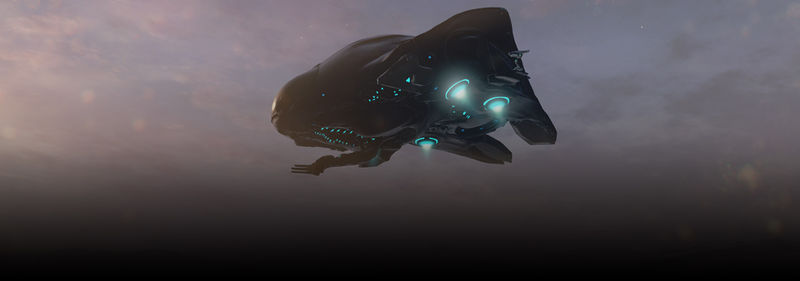
| « | The Phantom is a large, twin-engine combat dropship used by both the Covenant and Swords of Sanghelios. —
|
» |


Phantom
T-57 Dropship Troop Carrier
Manufacturer: Various
First Observed: 2557
Crew: 2 crew + 20 passengers
Length: 103.5ft (31.5m)
Width: 66ft (20.1m)
Height: 32.8ft (10m)
Summary
Agile and heavily armed, the Phantom is a versatile assault dropship used to ferry troops, armored vehicles, and even pre-fabricated fortifications from staging areas and carriers directly to the battlefield.
All Phantoms are large, twin-engine dropships with a sinuous design emblematic of Sangheili-engineered craft. The cockpit for the Phantom is located at the fore in an armored pod. The troop bay is accessed through the rear hatch, flank doors, or the dropship's integral gravity lift.
Propulsion
One impulse drive unit is fitted to each side of the Phantom, with the generators in front and control machinery stretching along the top of the craft until it terminates in control vanes in the rear.
Armament
Standard Phantom's are armed with a limited-rotation heavy plasma cannon turret installed on an armature located beneath the cockpit and two smaller plasma cannon door guns on the flanks.
Summary
T-44: The T-44 is currently the most common version of the Phantom. The warring Sangheili factions make extensive use of this variant, though the UNSC also captured a large number of these vehicles during combat operations on Requiem.
T-52: Introduced in the last year of the Human-Covenant War, the Type-52 was an improvement over the earlier T-44 in every way. Its sleek silhouette is imprinted in the minds of war survivors from Reach and Earth, making it the most well know of the Phantoms among humans. However, many Covenant forces never had the opportunity to use the T-52 before the loss of High Charity effectively ended its production.
T-57: Combat losses of the T-44 and T-52 have forced the Covenant and Swords of Sanghelios to turn to their allies and independent assembly forges for new dropships. The T-57 is easier to manufacture and maintain without access to high-tier fabrication facilities, at the sacrifice of exoatmospheric performance.
-
Ancienne illustration d'un Phantom T-57 dans Halo 5 : Guardians remplacée par celle d'un T-52 dans Halo 2 : Anniversary.
Revenant[modifier | modifier le wikicode]

| « | The Revenant a lightly armored infantry support vehicle designed to fill the gap between the Ghost’s maneuverability and the Wraith’s firepower. —
|
» |


Revenant
T-48 Light Assault Gun Carriage
Manufacturer: Merchants Of Qikost
First Observed: 2530
Crew: 1 Pilot + 1 Passenger
Maximum Speed: 80mph (128.7 km/h)
Length: 21.3ft (6.5m)
Width: 13.2ft (4m)
Height: 6.3ft (1.9m)
Weight: 2.4 Tons (2.2 Tonnes)
Summary
The Revenant is a lightly armored infantry support vehicle designed to fill the gap between the maneuverability of the Ghost and the brutal firepower of the Wraith. Interestingly, the design for the Revenant originated not from the Covenant’s vast war machine but from the Sangheili private sector. The Revenant was originally produced as a utility vehicle for Sangheili frontiersmen who ventured across the hunting preserves in the Qikost moon’s vast wilderness. However, the line between civilian and military application is vague on Sanghelios, where all vehicles can be pressed into combat use during clan wars or intra-keep squabbles.
Oddly, conversion of the Revenant to military application did not change its open cabin, essentially putting the operator and passenger at risk. Whether this is simply a vestigial attribute of the Revenant’s original design, or another Sangheili effort to display their fearlessness, is unknown. In any case, canny pilots keep the Revenant out of sight, and use the mortar’s indirect fire capability to strike from behind cover.
Armament
The military Revenant carries a Class-2 medium plasma mortar behind the operator; a class of weapon generally found only on Covenant weapon emplacements and much larger armored vehicles. The weapon’s rapid rate of fire and relatively short range complements the aggressive combat style of the Revenant’s Sangheili drivers, allowing them to provide devastating close artillery support for both ground troops and rapid-strike Ghost squads, and then redeploy to another engagement without pause.
Despite its popularity, the Revenant could not be produced in enough numbers to satisfy demand, and was rarely encountered by human forces until the ground campaign on Reach (or, more accurately, there were no survivors left to report its presence). After the Covenant War, Sangheili warlords were quick to acquire the vehicles by favor or force; thousands of Revenants were used during the civil war period, and proved adept at shattering Sangheili lives, homes, and fortresses.
Scorpion (original)[modifier | modifier le wikicode]

| « | The Scorpion is the UNSC’s main battle tank, with an extraordinary track record of success across dozens of planets and hundreds of battlefields. —
|
» |


Scorpion
M808 Main Battle Tank
Manufacturer: Acheron Security
Entered Service: 2218
Crew: 1 Operator + 1 Gunner
Length: 33.6ft (10.2m)
Width: 25.5ft (7.8m)
Height: 14.5ft (4.4m)
Weight: 66 Tons (59.9 Tonnes)
Maximum Speed: 60 Mph (96.5 Km/H)
Summary
The Scorpion’s rugged, adaptable design has changed little from its origins at the dawn of human interstellar colonization. This vehicles has remained in service due a combination of affordability, simplicity, and versatility that is difficult to match by other – supposedly superior – designs. The Scorpion’s functional uses are numerous and varied, though the UNSC uses it predominantly for direct assault, localized defense, and anti-armor operations.
The Scorpion’s design has become the template for all contemporary UNSC main battle tanks. Its heavy automation and reliable autoloader allows the tank to be operated by one individual, though the most common variants seat a secondary gunner to operate a pintle-mounted machine gun. The flat, broad-armored body is inset within four independently articulated bogies fitted with adaptive track segments. The track plates feature makeshift hard points that allow infantry to climb aboard the side of the tank and use it for transportation, though this is not recommended for use in combat zones.
Armament
Contemporary Scorpions are both resilient and mobile, equipped with a powerful M512 90mm smoothbore cannon for anti-tank and anti-fortification use, and a pintle-mounted M247 7.62mm medium machine gun which supplies efficient mid-range anti-infantry suppression.
Major Variants:
M808B: This older variant does not have the M247 pintle mount, but adds a coaxial M231 medium machine gun to the main turret, controlled by the operator.
M808B2: The “Sun Devil” variant replaces the 90mm cannon with two twin-linked 40mm autocannons. Ostensibly an anti-aircraft vehicle, the Sun Devil was used in an anti-personnel role throughout the insurrection years.
M808B3: Used for heavy fire support roles, the “Tarantula” variant with its two mounted pods on either side of the turret can fire clusters of hypervelocity Scimitar rockets. Its ineffectiveness against Covenant forces meant that most B3s were converted back to standard B models.
Scorpion (mise à jour)[modifier | modifier le wikicode]

| « | The Scorpion is the UNSC’s main battle tank, with an extraordinary track record of success across dozens of planets and hundreds of battlefields. —
|
» |

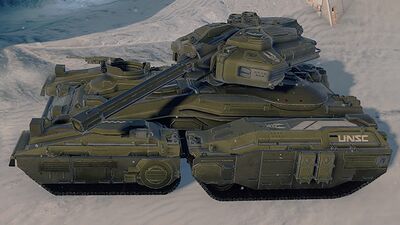
Scorpion
M820 Main Battle Tank
Manufacturer: Chalybs Defense Solutions<
Entered Service: 2557
Crew: 1 Operator + 1 Gunner
Maximum Speed: 80 Mph (128.7 Km/H)
Length: 33.6ft (10.2m)
Width: 27.8ft (8.5m)
Height: 18.7ft (5.7m)
Weight: 35 Tons (31.7 Tonnes)
Summary
The Scorpion’s rugged, adaptable design has changed little from its origins at the dawn of human interstellar colonization. This vehicles has remained in service due a combination of affordability, simplicity, and versatility that is difficult to match by other – supposedly superior – designs. The Scorpion’s functional uses are numerous and varied, though the UNSC uses it predominantly for direct assault, localized defense, and anti-armor operations.
The Scorpion’s design has become the template for all contemporary UNSC main battle tanks. Its heavy automation and reliable autoloader allows the tank to be operated by one individual, though the most common variants seat a secondary gunner to operate a pintle-mounted machine gun. The flat, broad-armored body is inset within four independently articulated bogies fitted with adaptive track segments. The track plates feature makeshift hard points that allow infantry to climb aboard the side of the tank and use it for transportation, though this is not recommended for use in combat zones.
Armament
The M820 Scorpion is just as heavily armored and mobile as its predecessors, and represents a new weapon platform without decades of deferred technology revisions and historical compromises.Most notably, the tanks M990 electrothermal-chemical (ETC) 150mm smoothbore cannon breaks legacy ammo compatibility with the M808 in order to accomodate both planned cannon-launched guided munitions and future advances in energetic propellants.
Major Variants:
M808C: Still in service with armored units throughout the UNSC Army and Marine Corps, the previous "mainline" iteration of the M808 features a M512 90mm smoothbore cannon for anti-tank and anti-fortification use, and a pintle-mounted M247T 7.62mm medium machine gun. It is substantially heavier than the M820, massing 66 tons (59.9 tonnes) when fully loaded.
M808B: This older variant does not have the M247 pintle mount, but adds a coaxial M231 medium machine gun to the main turret, controlled by the operator.
M808B2: The “Sun Devil” variant replaces the 90mm cannon with two twin-linked 40mm autocannons. Ostensibly an anti-aircraft vehicle, the Sun Devil was used in an anti-personnel role throughout the insurrection years.
M808B3: Used for heavy fire support roles, the “Tarantula” variant with its two mounted pods on either side of the turret can fire clusters of hypervelocity Scimitar rockets. Its ineffectiveness against Covenant forces meant that most B3s were converted back to standard B models.
M808: The first M808 model entered service in 2218.
Shadow of Intent[modifier | modifier le wikicode]

| « | Shadow of Intent is a Covenant assault carrier and flagship of Rtas ‘Vadum's Fleet of Retribution. —
|
» |

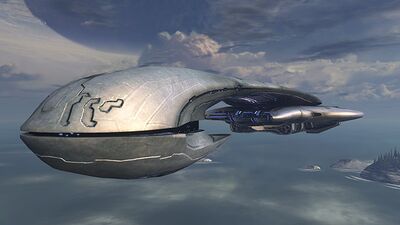
Shadow of Intent
CAS-Class
Length: 17,541ft (5,347m)
Beam: 6,948ft (2,118m)
Height: 2,448ft (746m)
Primary Armament: Ventral Cleansing Beam
Secondary Armament: Anterior Plasma Cannons
Tertiary Armament: Plasma Torpedo Silo Network
Quaternary Armament: Point Laser Defense
Summary
The Shadow of Intent is a Covenant CAS-class assault carrier, massive, and capable of carrying thousands of warriors and their instruments of war. It serves as the core of the Arbiter’s loyal fleet assets, and is commanded by the legendary Rtas ‘Vadum. In the post-War period, the vessel is both feared and revered as a herald of the Swords of Sanghelios.
Deployment
Very little is known of the Shadow of Intent’s operational history before the Great Schism. However, at the start of the Covenant civil war it was seized by Jiralhanae forces and turned against the Sangheili fleet staged outside High Charity. As the Arbiter fought to stop the firing of Delta Halo, special operations commander Rtas ‘Vadum led a strikeforce aboard the ship to retake control.
Song of Retribution[modifier | modifier le wikicode]

| « | Song of Retribution is an assault carrier that operates as the leading flagship of Jul ‘Mdama’s resurrected Covenant. —
|
» |


Song of Retribution
CAS Assault Carrier
Length: 17,541ft (5,347m)
Beam: 6,948ft (2,118m)
Height: 2,448ft (746m)
Primary Armament: Ventral Cleansing Beam
Secondary Armament: Anterior Plasma Cannons
Tertiary Armament: Plasma Torpedo Silo Network
Quaternary Armament: Point Laser Defense
Summary
After escaping the human-occupied shield world of Onyx (ONI Research Facility Trevelyan) Sangheili warlord Jul ‘Mdama accrued a number of vessels in an effort to form a reasonably sized fleet capable of engaging humanity. At the head of this newly resurrected Covenant flotilla was ‘Mdama’s flagship, Song of Retribution. The ship was a traditional CAS-class assault carrier capable of impressive speed and incredible firepower.
After ‘Mdama’s discovery of Requiem, he ordered the Song of Retribution to search for a way inside the shield world, but all attempts ended in failure. It would not be until after the derelict wreckage of the UNSC Forward Unto Dawn drifted toward Requiem that ‘Mdama would gain access to the planet’s interior. In an attempt to prevent humanity from accessing Requiem, ‘Mdama ordered his ships to attack the human vessel. Shortly thereafter, all ships in the area were captured by the planet’s gravity and pulled inside.
Following the Didact’s reawakening, ‘Mdama and the Song of Retribution participated in a series of campaigns on Requiem before eventually fleeing the doomed planet. The ship’s current location and fate remain a mystery.
Spectre[modifier | modifier le wikicode]

| « | The Spectre is a Covenant infantry support vehicle and was widely employed in the conflicts that took place on Delta Halo. —
|
» |


Spectre
T-46 Infantry Support Vehicle
Manufacturer: Assembly Forges
First Observed: 2546
Crew: 1 Driver + 1 Gunner + 2 Passengers
Maximum Speed: 74mph (119km/h)
Length: 21.2ft (6.5m)
Width: 16.6ft (5.1m)
Height: 11.6ft (3.5m)
Weight: 3.8 Tons (3.5 Tonnes)
Summary
First officially observed in 2546 during the Battle of Sargasso, the Spectre is one of a number of vehicles the Covenant employ to support infantry in combat. It was widely employed in the conflicts that took place on Delta Halo in 2552.
The Spectre is a simple vehicle by Covenant standards, with a heavy frame supporting two boosted-gravity generators on each side, with the driver located at the front in a light-armored operator station. A gunner operates the plasma cannon in a full-rotation turret, and up to two additional passengers can be accomodated, along with whatever firepower they bring with them.
Armament
The Spectre's mounted energy turret is catalogued by the UNSC as the T-46 Directed Energy Weapon/Mounted.
Shadow[modifier | modifier le wikicode]
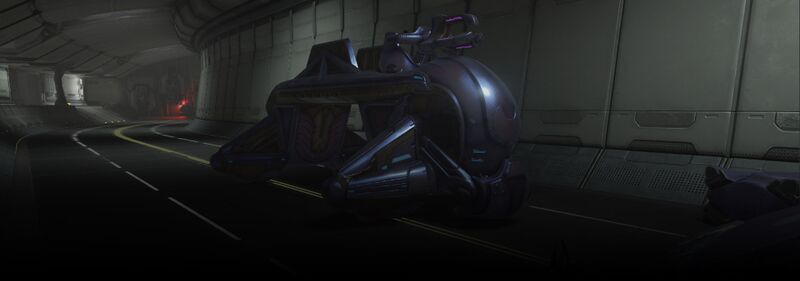
| « | The Shadow is a Covenant transport designed to carry troops and vehicles into combat. —
|
» |


Shadow
'
Manufacturer:
First Observed:
Crew:
Maximum Speed:
Length:
Width:
Height:
Weight:
Summary
Capable of carrying eight infantry on bench seats, or a single Ghost, the Shadow is analogous to human armored personnel carriers; it offers limited firepower and some protection but is an effective form of ground transportation. It is used during protracted occupations, when planetside troop deployment cannot be performed with traditional dropships due to lack of numbers or effective air defense. Shadows rarely move alone, and are usually seen in a convoy with Ghost escorts in groups of five-to-ten transports.
Armament
The Shadow utilizes the anti-infantry plasma cannon catalogued by the UNSC as the T-29 Anti-Infantry Weapon Emplacement/Mounted.
Scarab[modifier | modifier le wikicode]

| « | Scarabs are Lekgolo-driven walkers tasked with excavation missions in challenging terrain and siege operations against entrenched opponents. —
|
» |


Scarab
Ultra-Heavy Assault Platform
Manufacturer: Assembly Forges
First Observed: 2529
Crew: 1 Supervisor + 12 Passengers
Maximum Speed: 47 mph (76 km/h)
Length: 159.5ft (48.6m)
Width: 158.4ft (48.3m)
Height: 126.8ft (38.7m)
Weight: 189.4 Tons (171.8 Tonnes)
Summary
Scarabs are large, heavily armored all-terrain walkers employed by the Covenant and its successors as mobile bases, combat engineering vehicles, and heavy weapon platforms. All Scarabs make extensive use of Lekgolo worm colonies bound together with the platform’s control systems, though the gestalt is often barred from having complete control of their housing; Scarab meta-colonies were often populated by particularly unruly strains of Lekgolo that could not be left to their own devices without inviting ruin.
While confusing to humans, the Scarab was never considered a “vehicle” as such in Covenant service. The reliance on Lekgolo and their ability to operate independently led to Covenant categorization as ultra-heavy infantry when used in combat. Nevertheless, Scarabs were too valuable to operate without support, and most were accompanied by infantry and supervisory personnel when deployed in the field.
Armament
The defining system of all Scarabs is their focus cannon—a nearly capital-scale energy projector capable of either mass destruction or delicate stratigraphic excavation depending on tuning and the operator’s expertise (the Lekgolo alone have no fine control over the beam).
Most (but not all) Scarabs feature turret-mounted heavy plasma cannons and emplacement points for crew-served weapons for embarked defenders. Scarabs that lacked secondary heavy plasma cannons were often fitted communication and proselytization arrays in their stead, though the significance of this is unknown, and their role (if any) in Covenant military operations remains a subject of research within ONI.
Excavators
Scarabs are a family of related walkers within a larger class of constructs known as Excavators, which are organized by the Covenant into “tiers” denoting their size, digging efficacy, and delicacy. Nine Excavator tiers are noted in surviving records, though humans have only encountered three; all Scarabs are tier-four on this scale. Harvesters are tier-five Excavators, while Locusts are tier-one.
Variants
Five Scarab variations have been type classified by the UNSC, though only three are known to have been encountered by human forces in any number.
Type-29: Rarely encountered, the Type-29 Ultra-Heavy Site Excavator appears to have been a special-purpose excavation machine in Covenant service, deployed to reveal deeply buried Forerunner facilities, with limited combat utility; it could not self-deploy and had to be assembled on-site due to its delicate components and sheer size. The Type-29’s scarcity and the reverential language used in Covenant records indicate it may have been an ancient design used only to reveal particularly momentous reliquaries. Whatever its antiquity, the Type-29 was fitted with the most powerful focus beam of all known Scarabs.
Type-36: Almost certainly a field modification, Type-36 Ultra-Heavy Siege Platforms are fitted with a massive Class-4 plasma cannon, analogous to those fitted on the Type-27 Mantis[sic] platform. These vehicles used a range of different chassis designs, though their performance characteristics were nearly homogenous.
Type-47: Synonymous with “Scarab” to UNSC forces, Type-47 Ultra-Heavy Assault Platforms were type classified in 2547 despite occasional encounters as early as 2527. Rarely employed against the Outer Colonies, the Type-47 began to be fielded in large numbers near the end of the Covenant War to crush UNSC fortifications on Inner Colony worlds. Of special note is that due to a quirk of UNSC administration, two Scarab chassis types were designated the Type-47; unprecedented numbers of both permutations were deployed during the invasions of Reach and Earth.
Type-47B ‘Deutoros’: The most commonly encountered Type-47 Scarabs were autonomously operated by the Lekgolo contained within, effectively functioning as an exoskeleton for the gestalt intelligence of the inhabitants. Fitted with a focus cannon and secondary heavy plasma cannon, heavily armored, and surprisingly agile, the Deutoros rightly struck fear in the hearts of UNSC forces.
Type-47A ‘Protos’: Of unknown origins even to the Covenant forces that were issued them, the Protos towers roughly fifty meters into the air, dwarfing the Deutoros design. Rather than a single large plasma cannon as a secondary armament it used two separate suspensor-mounted heavy plasma repeaters optimized for anti-aerospace use. Covenant forces almost never used the Protos Scarabs for direct combat, and later analysis of Covenant records confirmed it was classed as a specialized artifact-retrieval vehicle, with a fine-tunable focus cannon and specialized sensor arrays that human forces rarely had the opportunity to observe as it burned its way through their defenses.
Spirit (original)[modifier | modifier le wikicode]

| « | The Spirit serves as a dropship and utility craft in Covenant and Swords of Sanghelios armies. —
|
» |


Spirit
T-25 Troop Carrier
Manufacturer: Assembly Forges
First Observed: 2525
Crew: 1 pilot + 30 passengers
Length: 108.4ft (33m)
Width: 59.5ft (18.1m)
Height: 38ft (11.6m)
Weight: 67.9 tons (61.6 tonnes)
Maximum Speed: 683 mph (1,099 km/h) in atmosphere
Summary
Much like the Phantom, the Spirit’s primary function is transportation of infantry and vehicles to and from combat zones. But, like all vehicles, its overall effectiveness is the net sum of its advantages and liabilities, and the Spirit has both.
One significant disadvantage is its ungainly split-fuselage design and claustrophobic troop bays. These features can make troop and vehicle deployment a frustrating affair for the pilot, and a harrowing experience for its passengers; especially after the UNSC learned to exploit its predictable deployment methodology. On the other hand, the hull is surprisingly robust, and pilot extremely well protected in the aft cockpit; a Spirit will survive combat zones that would prove suicidal for the somewhat more fragile Phantom.
Design
The Spirit’s shape is roughly that of a human tuning fork, with the pilot’s compartment at the rear and twin troop bays extending forward toward the front of the craft. Between the out-slung troop bays is a gravity hoist that can transport all but the heaviest Covenant vehicle. The Spirit can carry up to thirty Covenant infantry, split between the two troop bays.
Armament
Below the pilot’s cabin is the Spirit’s solitary defensive weapon, a low-mounted plasma cannon. ONI analysis shows that the cannon appears to be a slightly older variation of the weapon installed on the Type-25 Shade turret.
Spirit (mise à jour)[modifier | modifier le wikicode]

| « | The Spirit serves as a dropship and utility craft in Covenant and Swords of Sanghelios armies. —
|
» |


Spirit
T-57/T-25 Troop Carrier
Manufacturer: Assembly Forges/Merchants of Qikost
First Observed: 2525
Crew: 1 pilot + 30 passengers
Maximum Speed: 683 mph (1,099 km/h) in atmosphere
Length: 108.4ft (33m)
Width: 59.5ft (18.1m)
Height: 38ft (11.6m)
Weight: 67.9 tons (61.6 tonnes)
Summary
Much like the Phantom, the Spirit’s primary function is transportation of infantry and vehicles to and from combat zones. But, like all vehicles, its overall effectiveness is the net sum of its advantages and liabilities, and the Spirit has both.
One significant disadvantage is its ungainly split-fuselage design and claustrophobic troop bays. These features can make troop and vehicle deployment a frustrating affair for the pilot, and a harrowing experience for its passengers; especially after the UNSC learned to exploit its predictable deployment methodology. On the other hand, the hull is surprisingly robust, and pilot extremely well protected in the aft cockpit; a Spirit will survive combat zones that would prove suicidal for the somewhat more fragile Phantom.
Design
The Spirit’s baseline shape is roughly that of a human tuning fork, with the pilot’s compartment at the rear and twin troop bays extending forward toward the front of the craft. Between the out-slung troop bays is a gravity hoist that can transport all but the heaviest Covenant vehicle. Typically the Spirit can carry up to thirty Covenant infantry, split between the two troop bays.
Throughout the Covenant War, the most ubiquitously encountered Spirit model was easily the T-25 variant, which showcased design details more directly in line with the San’Shyuum’s aesthetic preferences.
Encountered more recently, the T-57 Spirit’s retains the craft’s prominent “tuning fork” shape, but incorporates a number of design evolutions iterated upon by the Merchants of Qikost, including a more streamlined profile, upgraded armor, improved in-atmosphere maneuverability, and faster troop-deployment. Rumors that the Sangheili artisans responsible for the T-57 Spirit accomplished the upgrades with the aid of a secretly-sequestered Huragok remain unsubstantiated.
Armament
Below the pilot’s cabin is the Spirit’s solitary defensive weapon, a low-mounted plasma cannon. ONI analysis shows that the cannon appears to be a slightly older variation of the weapon installed on the Type-25 Shade turret.
Tick[modifier | modifier le wikicode]
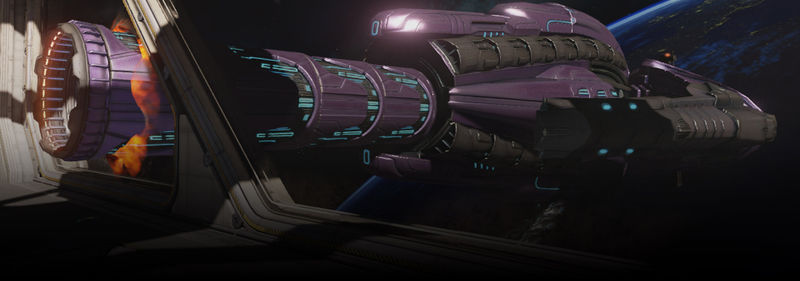
| « | The Tick is a Covenant boarding craft designed for strategic troop deployment onto enemy vessels or stations. —
|
» |
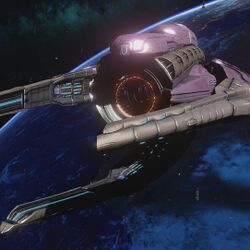
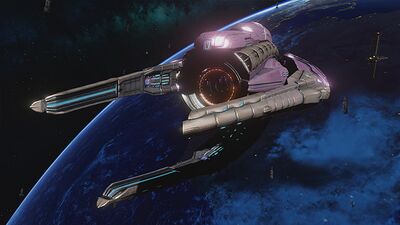
Tick
Type-28 Intrusion Vehicle
Manufacturer: Assembly Forges
Length: 204ft (62.2m)
Width: 116ft (35.4m)
Height: 92.2ft (28.1m)
Summary
Though the Covenant were all too often satisfied with simply burning their opponents at a distance with plasma torpedoes and beams, there were instances when a more up close and personal approach was deemed necessary due to sensitivity of the mission or defenses of the target.
Known as the “Tick” to Navy personnel, the Type-28 Intrusion Vehicle was among the specialized vehicles that Covenant fleets used to deliver boarding parties onto enemy ships and strongholds in order to secure high-value assets, destroy critical systems, and deploy antimatter demolition charges.
Operation
Ticks are carried on most large Covenant warships, and are occasionally used as general-purpose shuttles in addition to their role as a boarding craft. Fitted with extremely high-thrust impulse drives, the Tick can accelerate and decelerate at bone-crushing rates, with the pilot and passengers at the mercy of the vehicle’s occasionally unreliable inertial dampers.
Once a suitable entry point has been established, the Tick opens docking claspers, locks itself in place, and extends a breaching proboscis that burns and bores into the enemy’s hull. Once a passageway has been established, Covenant lances are able to exit the Tick’s troop compartment through the proboscis and begin conducting their mission. At the completion of the mission the Tick retracts the boarding tube, unclamps, and boost away.
UNSC Forward Unto Dawn[modifier | modifier le wikicode]

| « | The UNSC Forward Unto Dawn is well-known for its service in defense of Earth and its pursuit of Covenant forces through the Forerunner portal at Voi. —
|
» |
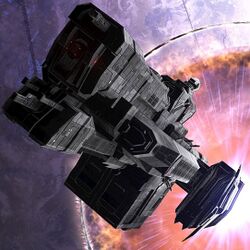

UNSC Forward Unto Dawn
FFG-201
Class: Charon-class Light Frigate
Length: 1,607ft (490m)
Beam: 510ft (156m)
Height: 457ft (139m)
Summary
The UNSC Forward Unto Dawn is a Charon-class light frigate that served on the frontlines during the final days of the Human-Covenant War under the distinguished command of both Admiral Hood and Commander Miranda Keyes. On November 17, 2552, the Forward Unto Dawn participated in the successful assault against the Prophet of Truth’s dreadnought as the Covenant hierarch attempted to activate the ancient Forerunner portal. After successfully defeating the Covenant Flood on the Forerunner Ark, the Master Chief, Cortana, and Arbiter Thel ‘Vadam used the Forward Unto Dawn to escape. During the attempt, however, the portal collapsed, severing the Dawn in two, sending only part of the ship containing the Arbiter back to Earth.
The aft section, still containing the Master Chief and his AI companion Cortana, floated in uncharted space for nearly five years. Eventually, it was pulled into the mysterious Forerunner fortress world of Requiem.
UNSC Infinity[modifier | modifier le wikicode]

| « | UNSC Infinity is the largest and most powerful vessel designed by the UNSC, designed prior to the end of the war as a final naval effort against the Covenant. —
|
» |


UNSC Infinity
INF-101
Class: Infinity-class Starship
Length: 18,682ft (5,694m)
Beam: 2,734ft (833m)
Height: 3,416ft (1,041m)
Primary Armament: CR-03, Series-8 MAC
Secondary Armament: M42 Archer Missile Delivery System
Tertiary Armament: M75 Rapier Missile Delivery System
Quaternary Armament: M96 Howler Missile Delivery System
Summary
Without equal throughout all of UNSC’s naval forces, Infinity is the largest, most powerful vessel ever employed by humanity. Prior to the end of the war, it was designed to contend with the Covenant—something the Navy had failed to do effectively for almost thirty years. After 2552, Infinity was publicly commissioned for peaceful exploration and research, but this changed when its crew came upon Requiem and was mercilessly pulled into its shielded outer surface. After managing to escape, Infinity returned several months later under the leadership of Captain Thomas Lasky and once again contended with the forces of Requiem.
Post-Requiem
In March of 2558, Commander Sarah Palmer deployed Fireteams Majestic, Fenrir and Colossus to repel an attack on the UNSC Infinity, preventing the freighter Pilgrims’ Pride from self-destructing on the ship.
After learning the freighter’s assault crafts belonged to the long-lost UNSC Spirit of Fire, Infinity’s AI Roland tracked the freighter’s launch origin to Oth Lodon, a gas giant located deep in Jiralhanae-controlled space. With the prospect of finally finding the Spirit of Fire, Lord Hood gave authorization to Commander Palmer to attempt a search and rescue. While scouting the system's asteroid field, Fireteam Majestic and Commander Palmer discovered not the Spirit of Fire but rather a Covenant station currently under control by New Colonial Alliance insurgents.
After the station surprised and disabled the Infinity, Commander Palmer and Spartan Thorne led Majestic in an effort to take control of the station. Eventually, Palmer and Majestic used the station’s own firepower against Covenant Shipmaster Vata 'Gajat's flagship, destroying it and saving the Infinity from further harm.
Unyielding Hierophant[modifier | modifier le wikicode]

| « | The Unyielding Hierophant was a Covenant battlestation that could service 500 ships, but was ultimately destroyed by Spartan Blue Team. —
|
» |


Unyielding Hierophant
Covenant Battlestation
Length: 18.6 miles (30 km)
Height: 2 Miles (3.2 km)
Beam: 6.2 Miles (10 km)
Power Source: Fusion Reactors
Destroyed: September 2552, Tau Ceti (Location)
Summary
Once described by Sergeant Major Avery Johnson as “a pair of squids kissing”, the Unyielding Hierophant’s role in the Covenant military was as important as its design was unique. Smaller, but similar in nature to the architecture of High Charity, the Unyielding Hierophant consisted of a pair of elongated, tear-drop structures with a narrow port and docks extending from each end. The interior of the massive space station was constructed to resemble a terrestrial setting, complete with animals, foliage, and slender corridors for internal transportation. At over 11 miles (18 kilometers) in length, it could field more than 500 Covenant ships, hundreds of thousands of troops, and enough firepower to destroy any ship within the UNSC.
Destruction
Led by Master Chief, a team of Spartan-II supersoldiers infiltrated the Unyielding Hierophant using a Covenant dropship. Once on the station, Spartan Blue Team soon learned that the Covenant intended to not only invade Earth, but to use this fleet to do so. Using a ruse to draw the outlying Covenant vessels toward the center of the station, the Spartans overloaded Unyielding Hierophant’s reactor, resulting in the destruction of the station and nearly all 500 surrounding ships.
UNSC Pillar of Autumn[modifier | modifier le wikicode]

| « | The UNSC Pillar of Autumn was deployed for Operation: RED FLAG, and eventually found its way to Alpha Halo and the critical discovery of the Forerunners. —
|
» |
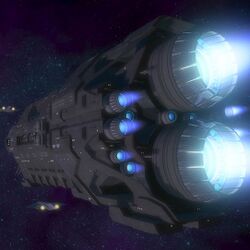

UNSC Pillar of Autumn
C-709
Class: Halcyon-Class Light Cruiser
Length: 3,841ft (1,171m)
Beam: 1,156ft (352m)
Primary Armament: Mark II, Light Coil - 56A2D4/MAC
Secondary Armament: M58 Archer Missile Delivery System
Tertiary Armament: M910 Rampart 50mm Point Defense Network
Summary
Built in 2510, the Pillar of Autumn served the UNSC during both the rebellion and the conflict with the Covenant. In 2552, it was extensively upgraded for Operation: RED FLAG, a classified mission that intended to send it and its crew deep into Covenant-controlled space. RED FLAG’s goal was the capture of a Covenant Prophet, but when the aliens suddenly arrived at Reach, the Autumn narrowly evaded their assault by escaping into the unknown of slipspace. Eventually, they arrived at Installation 04, where the UNSC came face to face with the threat of both Halo and the Flood.
UNSC In Amber Clad[modifier | modifier le wikicode]

| « | In Amber Clad is a UNSC light frigate helmed by Commander Miranda Keyes during the Covenant’s assault on Earth. —
|
» |


UNSC In Amber Clad
FFG-142
Class: Stalwart-Class Light Frigate
Length: 1,568ft (478m)
Beam: 498ft (152m)
Height: 368ft (112m)
Primary Armament: Mark II Light MAC
Secondary Armament: M58 Archer Missile Delivery System
Tertiary Armament: M870 Rampart Point Defense Network
Summary
In April of 2550, Miranda Keyes assumed command of the light frigate In Amber Clad and led its crew against the Covenant on the front lines of the war. On October 20, 2552, while docked at Cairo Station to participate in an award ceremony for her late father, Captain Jacob Keyes, the Covenant arrived at Earth, forcing Commander Miranda Keyes into action. In Amber Clad deployed a number of assets, including the Master Chief, to New Mombasa, which was the Covenant’s primary focus during this initial assault. When the Covenant flagship, Solemn Penance, fled into slipspace, In Amber Clad pursued it, following it to Delta Halo.
In Amber Clad facilitated local forces in hunting down the High Prophet of Regret at Delta Halo, preventing the Covenant from activating the installation. During the course of this battle, the Flood escaped from the ring’s quarantine zone. Although some human forces deployed on the ring survived this outbreak, In Amber Clad’s crew tragically fell prey to the parasite and was used by the Gravemind to transport the Flood to the nearby Covenant homeworld of High Charity. Impaled in an interior wall of the Covenant station’s superstructure, the ship at last found its end.
Ultimately, the frigate became part of High Charity’s debris field on the Ark installation after the Gravemind took the Covenant city to the heart of the Halo Array’s control center.
UNSC Cruiser[modifier | modifier le wikicode]

| « | Cruisers are large UNSC capital ships generally utilized for their heavy armament and extraordinary resilience. —
|
» |


UNSC Cruiser
Halcyon, Marathon, Valiant, and Autumn
Affiliation: Human
Purpose: Attack, Transportation
Length: Varies based on class
Primary Armament: Heavy MAC
Secondary Armament: Missile Delivery System
Tertiary Armament: Point Defense Network
Summary
Cruisers are the backbone of the UNSC fleet, though they are often dwarfed by their Covenant counterparts in both size and firepower. Few human cruisers survived to see the end of the Covenant War, though new designs are currently being produced in limited numbers.
Halcyon-class
Designed in 2510 CE, the Halcyon-class only saw a brief era of service due to cost, a lack of speed, poor initial armament, and other concerns regarding its tactical viability.
Role: Attack, defense Length: 3,841ft (1,171m)
Marathon-class
Due to their durability and firepower, Marathon-class cruisers were often reserved for use as command ships.
Role: Command, attack Length: 3,910ft (1,191m)
Valiant-class
The Valiant-class was a super-heavy cruiser dedicated to command-and-control of fleet operations.
Role: Command Length: 4,980ft (1,518m)
Autumn-class
The Autumn-class is a post-War design slated to form the core of the reconstituted UNSC Navy’s task forces.
Role: Attack Length: 4,674ft (1,425m)
Warthog (original)[modifier | modifier le wikicode]

| « | The Warthog is the UNSC's primary ground transportation vehicle and developed by AMG Transport Dynamics. —
|
» |


Warthog
M12 Force Application Vehicles
Manufacturer: AMG Transport Dynamics
Entered Service: 2319
Crew: 1 driver + 1 passenger (varies by model)
Length: 20.5ft (6.3m)
Width: 20.5ft (6.3m)
Height: 8.1ft (2.5m)
Weight: 3.25 tons (3 tonnes)
Maximum Speed: 78mph (125km/h)
Summary
The Warthog is the UNSC's primary ground transportation vehicle. It offers several variants typically differentiated by their mounted weapon systems. While some Warthogs are intended solely for transportation, most types provide exceedingly versatile anti-aircraft or anti-armor options, which further optimize the vehicles’ light armor and deft mobility.
The Warthog is a four-wheel, all-terrain vehicle with a forward-housed, low-profile, liquid-cooled, hydrogen-burning internal combustion engine (ICE) which powers an automatic infinitely variable transmission (IVT). Warthog’s maintain a large, light-armored frame, with heavy grade nanotube-lined wheels (previously inert-gas pocket) and a high suspension system. They bear a towing winch system with hooks somewhat resembling the tusks of a warthog (hence its name). The Warthog's hydrogen tanks can power the vehicle for up to 490 miles (790 kilometers) before refueling. In field conditions, operators can use the Graf/Hauptman solar-powered electrolysis and compression system to filter water or crack it into fuel. These features, coupled with a rugged, in-field resiliency have maintained the Warthog’s renowned legacy for decades.
History
AMG Transport Dynamics designed the first Warthog prototype in 2319. The Z-12 prototype vehicles quickly made a name for themselves due to AMG's well-crafted advertising campaign and exceptional engineering team that showcased the prototype’s impressive feature set and unparalleled functionality in the unpopulated outlands of both Luna and Mars. It was lauded as the vehicle that could go anywhere and do anything.
During the first eight months of the prototype’s existence, AMG Transport Dynamics received over three dozen exclusivity contracts, the largest and most lucrative being with the Colonial Military Administration (CMA). By 2321, AMG Transport Dynamics had secured a deal with the CMA to meet nearly all of their land-based transportation needs. It was at this time that the Z-12 became the M12 Force Application Vehicle (FAV) with the addition of a pneumatically powered swivel mount and armored body panels.
By 2329, the ‘Warthog,’ as it was called by CMA personnel, had become the most common military all-terrain vehicle, closely trailed by AMG Transport Dynamics’ Mongoose and Civet. Over two hundred years later, after more than a dozen iterative changes, the M12 FAV remains the standard utility vehicle in UNSC service. The vehicle is so ubiquitous that all UNSC personnel are required to know how to operate and maintain the M12 FAV, regardless of military specialty or branch of service.
Major Variants
The standard Warthog offers two seats (driver, side passenger) and a cargo bed for carrying equipment or other personnel. Variants of the Warthog have been in service with UNSC forces for over two centuries.
M12: The most common series within the FAV platform is the M12 Light Reconnaissance Vehicle (LRV) fitted with a pneumatically powered, 360-degree rotation multi-purpose M46 Vulcan Machine Gun. Major variants are informally denoted by their year of production.
M12A1: The M12A1 Light Anti-armor Vehicle (LAAV) "Rocket Hog" saw limited use, but packed an impressive amount of firepower onto a mobile platform in the form of a heavy M39 Rocket Turret.
M12G: The primary anti-armor variant of the FAV platform is easily the M12G LAAV, which leverages the devastatingly effective Gauss Cannon.
M12R: Equipped with an M79 Multiple Launch Rocket System (MLRS), the M12R "Missile Hog" proved invaluable in operations such as the Szurdok Ridge offensive on Reach in 2552.
M831: The standard non-combat Warthog used for personnel transport. Instead of armament, the M831 "Troop Hog" features a protective roll-cage and seating for up to four passengers in side-facing bench seats. A high-powered spotlight is also fitted. While the passengers can generate an impressive amount of firepower (if properly equipped), they are also exposed to enemy attack and vulnerable to rollovers and other catastrophes. The four subvariants: M831A, M831B, M831C, and M831D differ in minor ways.
M862: Referred to as the "Arctic Hog", this extreme-environment variant features an enclosed-cabin and quad-tracks, allowing it to scale icy heights and travel over deep snow.
M864: Though modified for cold-weather operations, the M864 does not have the extreme mobility modifications of the M862.
M868: Hostile-environment variant for operations in tropical environment. Most notable changes are a further ruggedized suspension and double application of anti-corrosion coatings.
M914: Utilitarian by nature, the M914 Recovery Transport is a rare variant designed for extraction of Warthogs that have become immobilized, and for use as a mobile repair bay.
The Hog: Civilian variant of the M12.
Warthog (mise à jour)[modifier | modifier le wikicode]

| « | The Warthog is the UNSC's primary ground transportation vehicle and developed by AMG Transport Dynamics. —
|
» |


Warthog
M12 Force Application Vehicles
Manufacturer: AMG Transport Dynamics
Entered Service: 2319
Crew: 1 driver + 1 passenger (varies by model)
Length: 20.5ft (6.3m)
Width: 20.5ft (6.3m)
Height: 8.1ft (2.5m)
Weight: 3.25 tons (3 tonnes)
Maximum Speed: 78mph (125km/h)
Summary
The Warthog is the UNSC's primary ground transportation vehicle. It offers several variants typically differentiated by their mounted weapon systems. While some Warthogs are intended solely for transportation, most types provide exceedingly versatile anti-aircraft or anti-armor options, which further optimize the vehicles’ light armor and deft mobility.
The Warthog is a four-wheel, all-terrain vehicle with a forward-housed, low-profile, liquid-cooled, hydrogen-burning internal combustion engine (ICE) which powers an automatic infinitely variable transmission (IVT). Warthog’s maintain a large, light-armored frame, with heavy grade nanotube-lined wheels (previously inert-gas pocket) and a high suspension system. They bear a towing winch system with hooks somewhat resembling the tusks of a warthog (hence its name). The Warthog's hydrogen tanks can power the vehicle for up to 490 miles (790 kilometers) before refueling. In field conditions, operators can use the Graf/Hauptman solar-powered electrolysis and compression system to filter water or crack it into fuel. These features, coupled with a rugged, in-field resiliency have maintained the Warthog’s renowned legacy for decades.
History
AMG Transport Dynamics designed the first Warthog prototype in 2319. The Z-12 prototype vehicles quickly made a name for themselves due to AMG's well-crafted advertising campaign and exceptional engineering team that showcased the prototype’s impressive feature set and unparalleled functionality in the unpopulated outlands of both Luna and Mars. It was lauded as the vehicle that could go anywhere and do anything.
During the first eight months of the prototype’s existence, AMG Transport Dynamics received over three dozen exclusivity contracts, the largest and most lucrative being with the Colonial Military Administration (CMA). By 2321, AMG Transport Dynamics had secured a deal with the CMA to meet nearly all of their land-based transportation needs. It was at this time that the Z-12 became the M12 Force Application Vehicle (FAV) with the addition of a pneumatically powered swivel mount and armored body panels.
By 2329, the ‘Warthog,’ as it was called by CMA personnel, had become the most common military all-terrain vehicle, closely trailed by AMG Transport Dynamics’ Mongoose and Civet. Over two hundred years later, after more than a dozen iterative changes, the M12 FAV remains the standard utility vehicle in UNSC service. The vehicle is so ubiquitous that all UNSC personnel are required to know how to operate and maintain the M12 FAV, regardless of military specialty or branch of service.
Major Variants
The standard Warthog offers two seats (driver, side passenger) and a cargo bed for carrying equipment or other personnel. Variants of the Warthog have been in service with UNSC forces for over two centuries.
M12: The most common series within the FAV platform is the M12 Light Reconnaissance Vehicle (LRV) fitted with a pneumatically powered, 360-degree rotation multi-purpose light anti-aircraft machine gun. Major variants are informally denoted by their year of production.
M12A1: The M12A1 Light Anti-armor Vehicle (LAAV) "Rocket Hog" saw limited use, but packed an impressive amount of firepower onto a mobile platform in the form of a heavy M39 Rocket Turret.
M12G: The primary anti-armor variant of the FAV platform is easily the M12G LAAV, which leverages the devastatingly effective Gauss Cannon.
M12R: Equipped with an M79 Multiple Launch Rocket System (MLRS), the M12R "Missile Hog" proved invaluable in operations such as the Szurdok Ridge offensive on Reach in 2552.
M831: The standard non-combat Warthog used for personnel transport. Instead of armament, the M831 "Troop Hog" features a protective roll-cage and seating for up to four passengers in side-facing bench seats. A high-powered spotlight is also fitted. While the passengers can generate an impressive amount of firepower (if properly equipped), they are also exposed to enemy attack and vulnerable to rollovers and other catastrophes. The four subvariants: M831A, M831B, M831C, and M831D differ in minor ways.
M862: Referred to as the "Arctic Hog", this extreme-environment variant features an enclosed-cabin and quad-tracks, allowing it to scale icy heights and travel over deep snow.
M864: Though modified for cold-weather operations, the M864 does not have the extreme mobility modifications of the M862.
M868: Hostile-environment variant for operations in tropical environment. Most notable changes are a further ruggedized suspension and double application of anti-corrosion coatings.
M914: Utilitarian by nature, the M914 Recovery Transport is a rare variant designed for extraction of Warthogs that have become immobilized, and for use as a mobile repair bay.
The Hog: Civilian variant of the M12.
Warthog (version corrigée)[modifier | modifier le wikicode]

| « | The Warthog is the UNSC's primary ground transportation vehicle and developed by AMG Transport Dynamics. —
|
» |


Warthog
M12 Force Application Vehicles
Manufacturer: AMG Transport Dynamics
Entered Service: 2319
Crew: 1 driver + 1 passenger (varies by model)
Maximum Speed: 78mph (125km/h)
Length: 20.5ft (6.3m)
Width: 20.5ft (6.3m)
Height: 8.1ft (2.5m)
Weight: 3.25 tons (3 tonnes)
Summary
The Warthog is the UNSC's primary ground transportation vehicle. It offers several variants typically differentiated by their mounted weapon systems. While some Warthogs are intended solely for transportation, most types provide exceedingly versatile anti-aircraft or anti-armor options, which further optimize the vehicles’ light armor and deft mobility.
The Warthog is a four-wheel, all-terrain vehicle with a forward-housed, low-profile, liquid-cooled, hydrogen-burning internal combustion engine (ICE) which powers an automatic infinitely variable transmission (IVT). Warthog’s maintain a large, light-armored frame, with heavy grade nanotube-lined wheels (previously inert-gas pocket) and a high suspension system. They bear a towing winch system with hooks somewhat resembling the tusks of a warthog (hence its name). The Warthog's hydrogen tanks can power the vehicle for up to 490 miles (790 kilometers) before refueling. In field conditions, operators can use the Graf/Hauptman solar-powered electrolysis and compression system to filter water or crack it into fuel. These features, coupled with a rugged, in-field resiliency have maintained the Warthog’s renowned legacy for decades.
History
AMG Transport Dynamics designed the first Warthog prototype in 2319. The Z-12 prototype vehicles quickly made a name for themselves due to AMG's well-crafted advertising campaign and exceptional engineering team that showcased the prototype’s impressive feature set and unparalleled functionality in the unpopulated outlands of both Luna and Mars. It was lauded as the vehicle that could go anywhere and do anything.
During the first eight months of the prototype’s existence, AMG Transport Dynamics received over three dozen exclusivity contracts, the largest and most lucrative being with the Colonial Military Administration (CMA). By 2321, AMG Transport Dynamics had secured a deal with the CMA to meet nearly all of their land-based transportation needs. It was at this time that the Z-12 became the M12 Force Application Vehicle (FAV) with the addition of a pneumatically powered swivel mount and armored body panels.
By 2329, the ‘Warthog,’ as it was called by CMA personnel, had become the most common military all-terrain vehicle, closely trailed by AMG Transport Dynamics’ Civet ATV. Over two hundred years later, after more than a dozen iterative changes, the M12 FAV remains the standard utility vehicle in UNSC service. The vehicle is so ubiquitous that all UNSC personnel are required to know how to operate and maintain the M12 FAV, regardless of military specialty or branch of service.
Major Variants
The standard Warthog offers two seats (driver, side passenger) and a cargo bed for carrying equipment or other personnel. Variants of the Warthog have been in service with UNSC forces for over two centuries.
M12: The most common series within the FAV platform is the M12 Light Reconnaissance Vehicle (LRV) fitted with a pneumatically powered, 360-degree rotation multi-purpose light anti-aircraft machine gun. Major variants are informally denoted by their year of production.
M12A1: The M12A1 Light Anti-armor Vehicle (LAAV) "Rocket Hog" saw limited use, but packed an impressive amount of firepower onto a mobile platform in the form of a heavy M39 Rocket Turret.
M12G: The primary anti-armor variant of the FAV platform is easily the M12G LAAV, which leverages the devastatingly effective Gauss Cannon.
M12R: Equipped with an M79 Multiple Launch Rocket System (MLRS), the M12R "Missile Hog" proved invaluable in operations such as the Szurdok Ridge offensive on Reach in 2552.
M831: The standard non-combat Warthog used for personnel transport. Instead of armament, the M831 "Troop Hog" features a protective roll-cage and seating for up to four passengers in side-facing bench seats. A high-powered spotlight is also fitted. While the passengers can generate an impressive amount of firepower (if properly equipped), they are also exposed to enemy attack and vulnerable to rollovers and other catastrophes. The four subvariants: M831A, M831B, M831C, and M831D differ in minor ways.
M862: Referred to as the "Arctic Hog", this extreme-environment variant features an enclosed cabin and quad-tracks, allowing it to scale icy heights and travel over deep snow.
M864: Though modified for cold-weather operations, the M864 does not have the extreme mobility modifications of the M862.
M868: Hostile-environment variant for operations in a tropical environment. Most notable changes are a further ruggedized suspension and double application of anti-corrosion coatings.
M914: Utilitarian by nature, the M914 Recovery Transport is a rare variant designed for extraction of Warthogs that have become immobilized, and for use as a mobile repair bay.
The Hog: Civilian variant of the M12.
Wraith (original)[modifier | modifier le wikicode]

| « | The Covenant Wraith is an armored mortar tank, created to besiege enemy positions with an unrelenting firepower. —
|
» |


Wraith
T-26 Assault Gun Carriage
Manufacturer: Lodam Armory
First Observed: 2526
Crew: 1 Operator + 1 Gunner
Length: 29ft (8.8m)
Width: 30.1ft (9.2m)
Height: 12.3ft (3.8m)
Weight: 51.8 Tons (47 Tonnes)
Maximum Speed: 51mph (82km/h)
Summary
With a distinctively aggressive design, the Wraith is one of the most recognizable Covenant vehicles currently in use. Armed with a heavy plasma mortar that can shatter even heavily reinforced defenses from long distances, the tank is also quite effective in close-range fights – particularly in the hands of a skilled operator. Despite its large size, the boosted gravity drive of the Wraith allows for impressive bursts of speed and surprisingly nimble maneuvers over most terrain types.
Wraith (mise à jour)[modifier | modifier le wikicode]

| « | The Wraith is an armored mortar tank, created to besiege enemy positions with unrelenting firepower. —
|
» |


Wraith
T-58 Assault Gun Carriage
Manufacturer: Lodam Armory
Primary Armament: T-58 35cm DEM
Secondary Armament: T-58 DEWE
Maximum Speed: 51mph (82km/h)
Length: 27.9ft (8.5m)
Width: 27.1ft (8.3m)
Height: 17.4ft (5.3m)
Weight: 46.5 tons (42.3 tonnes)
Summary
With a distinctively aggressive design, the Wraith is one of the most recognizable vehicles currently in use by Swords of Sanghelios and Covenant forces. Armed with a plasma mortar that can shatter even heavily reinforced defenses from long distances, the tank is lethal at range. Yet, in the hands of a skilled operator, it can also be quite effective in closer engagements. Despite the Wraith’s large size, its boosted gravity drive allows for impressive bursts of speed and surprisingly agile maneuvers over most terrain.
Variants
As with all Covenant vehicles, several major variants of the Wraith exist. By Covenant measures of standardization these are effectively identical, though ONI’s obsessive categorization identified dozens, if not hundreds, of distinct permutations.
Type-26: Surprisingly lightweight and nimble considering its bulk, the T-26 Assault Gun Carriage is armed with a heavy plasma mortar as its primary armament. Most also feature one or two crew-served or automated plasma cannon turrets for close-in defense and infantry suppression.
Type-52: This variant replaces the plasma mortar with two triple-rack fuel rod cannons. Though obviously intended to be an anti-aircraft vehicle, the Type-52 can - and was - also used in a direct-fire role to devastating effect.
Type-58: Thought to be a new design, the Type-58 incorporates advanced technologies that would have never been approved by San’Shyuum clerical authorities. Most of these vehicles are found on Sanghelios, though it is only a matter of time before it becomes more widespread as combat losses of other Wraiths mount.





